Index Catalog Objects: IC 650 (original) (raw)
QuickLinks:
650, 651, 652, 653, 654, 655, 656, 657, 658, 659, 660, 661, 662, 663, 664, 665, 666,
667, 668, 669, 670, 671, 672, 673, 674, 675, 676, 677, 678, 679, 680, 681, 682, 683,
684, 685, 686, 687, 688, 689, 690, 691, 692, 693, 694, 695, 696, 697, 698, 699
Page last updated Feb 4, 2020
Took care of some formatting updates, and completed the entry for IC 694
WORKING: Check historical/physical information
IC 650 (= PGC 170094)
Discovered (Apr 21, 1892) by Stephane Javelle (186)
A 15th-magnitude spiral galaxy (type Sc? pec) in Hydra (RA 10 50 40.5, Dec -13 26 31)
Based on a recessional velocity of 8105 km/sec, IC 650 is about 375 million light years away. Given that and its apparent size of 0.95 by 0.55 arcmin, it is about 100 thousand light years across.

Above, a 2.4 arcmin wide closeup of IC 650
Below, a 12 arcmin wide region centered on the galaxy
IC 651 (= PG 32517)
Discovered (Mar 21, 1893) by Stephane Javelle (700)
A 13th-magnitude spiral galaxy (type SB(s)m pec?) in Sextans (RA 10 50 58.4, Dec -02 09 02)
Apparent size 0.8 by 0.8 arcmin.

Above, a 2.4 arcmin wide closeup of IC 651
Below, a 12 arcmin wide region centered on the galaxy
IC 652 (= NGC 3421 = PGC 32514)
Discovered (1880) by Andrew Common (and later listed as NGC 3421)
Discovered (Apr 19, 1892) by Stephane Javelle (and later listed as IC 652)
A 14th-magnitude spiral galaxy (type (R')SB(rs)a pec) in Hydra (RA 10 50 57.7, Dec -12 26 55)
Per Dreyer, IC 652 (Javelle #187, 1860 RA 10 44 04, NPD 101 53.8) is "faint, very small, round, brighter middle". The position precesses to RA 10 51 01.6, Dec -12 38 15, but there is nothing there. Per Corwin, the problem appears to be that Javelle misidentified his comparison star. He recorded it as BD -11 2960, but it was undoubtedly BD -11 2959. Using the coordinates for the latter star, Javelle's micrometric offsets fall within 5 arcsec of the center of the galaxy, so the identification is certain. The duplicate entry was caused by Javelle's error and an even larger error made by Common for the NGC listing, resulting in a difference of 25 arcmin between the observations. Under such circumstances there is no way that Dreyer could have realized that the two entries had anything in common. For a discussion of the NGC identification (and anything else) see NGC 3421.
IC 653 (= PGC 32611)
Discovered (Apr 10, 1893) by Stephane Javelle (701)
A 13th-magnitude spiral galaxy (type S??) in Leo (RA 10 52 06.7, Dec -00 33 40)
Apparent size 2.3 by 1.0 arcmin.

Above, a 2.4 arcmin wide closeup of IC 653
Below, a 12 arcmin wide region centered on the galaxy
IC 654 (= PGC 32716)
Discovered (Apr 21, 1892) by Stephane Javelle (188)
A 14th-magnitude spiral galaxy (type (R')SB0+?) in Crater (RA 10 53 50.4, Dec -11 43 33)
Apparent size 1.1 by 0.35 arcmin.
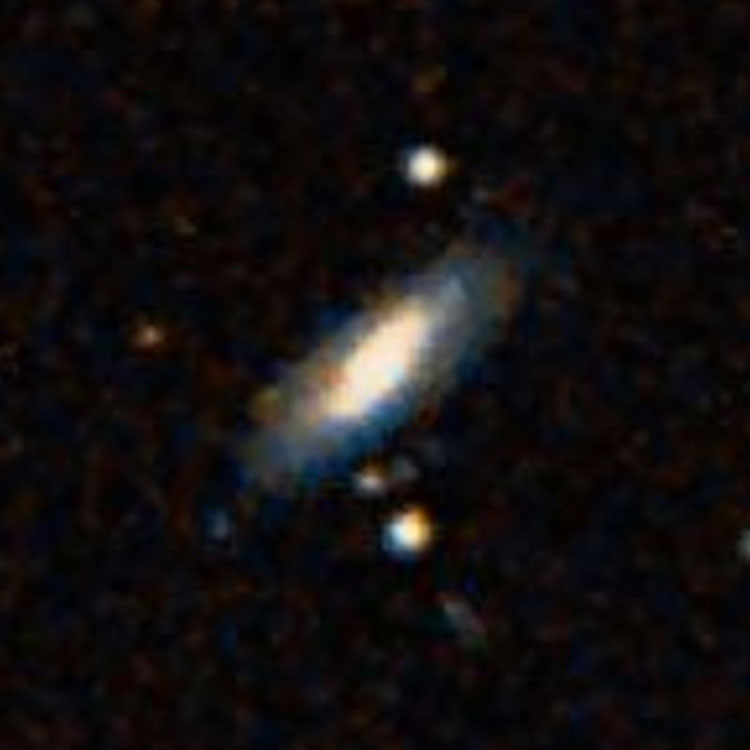
Above, a 2.4 arcmin wide closeup of IC 654
Below, a 12 arcmin wide region centered on the galaxy
IC 655 (= PGC 32758)
Discovered (Apr 22, 1892) by Stephane Javelle (189)
A 15th-magnitude spiral galaxy (type SABab?) in Leo (RA 10 54 22.3, Dec -00 21 56)
Apparent size 0.85 by 0.2 arcmin.

Above, a 2.4 arcmin wide closeup of IC 655
Below, a 12 arcmin wide region centered on the galaxy
IC 656 (3 stars + PGC 1537008)
Discovered (Mar 15, 1887) by Guillaume Bigourdan
Two 15th-magnitude stars and a 16th-magnitude star in Leo (RA 10 55 07.9, Dec +17 36 48)
plus a 16th-magnitude spiral galaxy (type Sab?) at RA 10 55 08.7, Dec +17 36 43
Per Dreyer, IC 656 (Bigourdan #161, 1860 RA 10 47 40, NPD 71 39) is "very small, a cluster, possibly nebulous". The position precesses to RA 10 55 08.2, Dec +17 36 18, just south of the trapezoid of three stars and a galaxy listed above, so the identification is certain. Per Corwin, there is a remote possibility that this is also NGC 3457, whose identification is not as certain, but odds are they are different objects, as shown in the wide-field image below. The three stars lie within our own galaxy, but based on its recessional velocity of 25690 km/sec, a straightforward calculation indicates that PGC 1537008 is nearly 1200 million light years away. However, for objects at such distances we should take into account the Universal expansion during the time it took their light to reach us. Doing that shows that the galaxy was about 1080 million light years away at the time the light by which we see it was emitted, about 1130 million years ago (the difference between the two numbers being due to the expansion of the intervening space during the light-travel time). Given that and its apparent size of 0.35 by 0.25 arcmin, it is about 110 thousand light years across.

Above, a 2.4 arcmin wide closeup of IC 656
Below, a 12 arcmin wide region centered on the grouping, also showing NGC 3457
IC 657 (= PGC 32966)
Discovered (May 18, 1893) by Stephane Javelle (702)
A 15th-magnitude spiral galaxy (type SB(rs)a?) in Leo (RA 10 57 53.5, Dec -04 54 18)
Apparent size 1.35 by 0.45 arcmin. A Seyfert galaxy (type Sy 2).
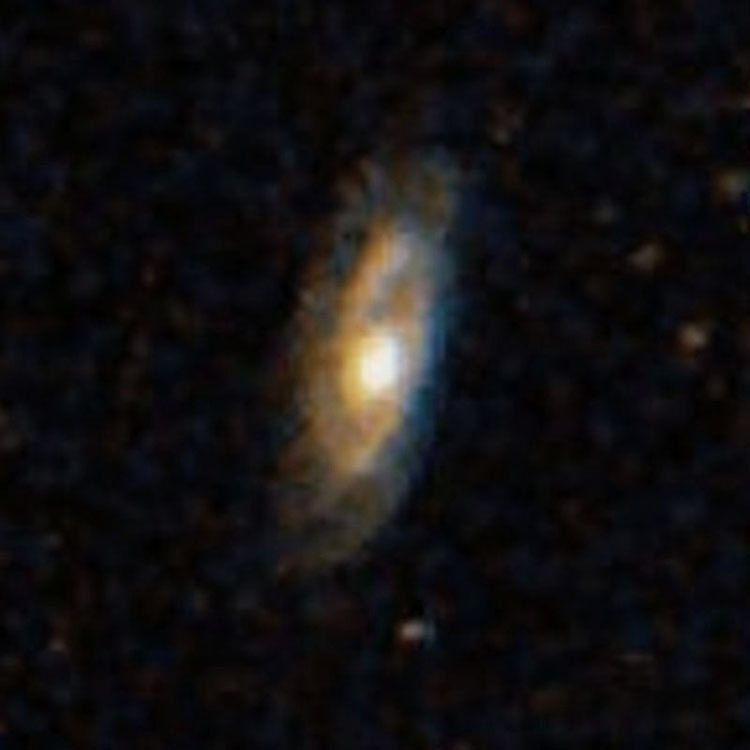
Above, a 2.4 arcmin wide closeup of IC 657
Below, a 12 arcmin wide region centered on the galaxy
IC 658 (= PGC 33004)
Discovered (Apr 19, 1893) by Stephane Javelle (703)
A 13th-magnitude lenticular galaxy (type S0/a? pec) in Leo (RA 10 58 16.3, Dec +08 14 30)
Apparent size of main galaxy is 0.7 by 0.7 arcmin; with the arm extended to the east, it is 1.3 by 0.7 arcmin.

Above, a 2.4 arcmin wide closeup of IC 658
Below, a 12 arcmin wide region centered on the galaxy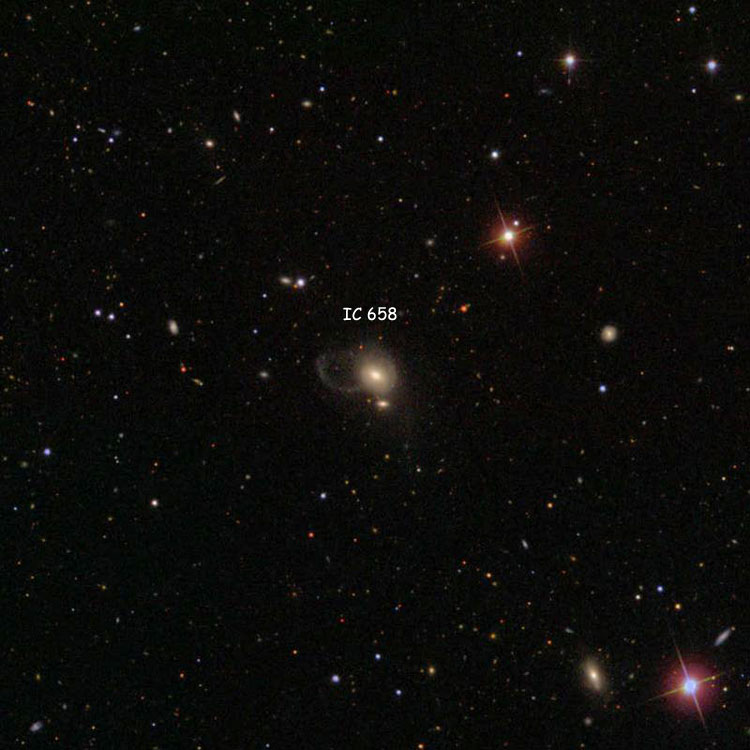
IC 659 (= PGC 32979)
Discovered (May 4, 1893) by Stephane Javelle (704)
A 14th-magnitude elliptical galaxy (type E2?) in Leo (RA 10 58 03.9, Dec -06 15 37)
Apparent size 1.2 by 1.0 arcmin.
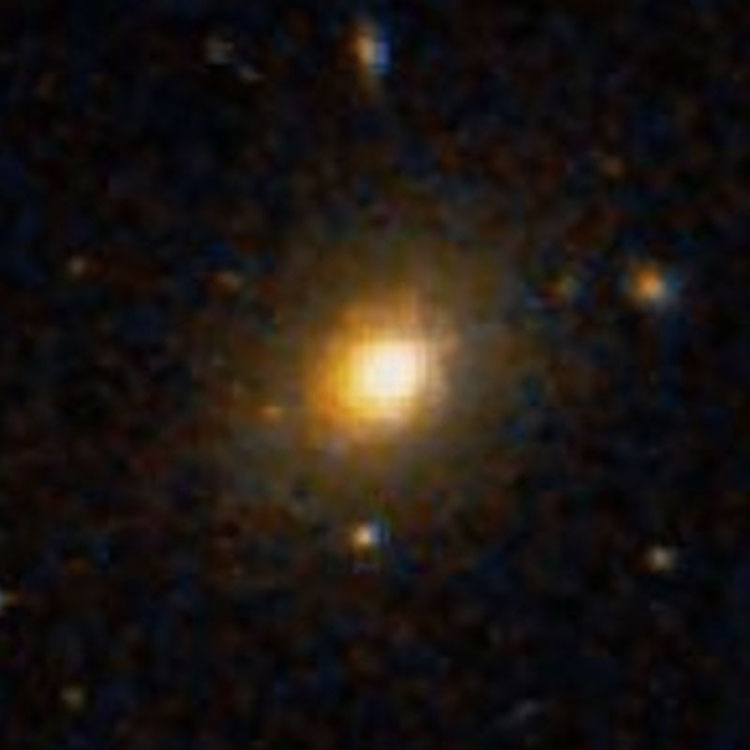
Above, a 2.4 arcmin wide closeup of IC 659
Below, a 12 arcmin wide region centered on the galaxy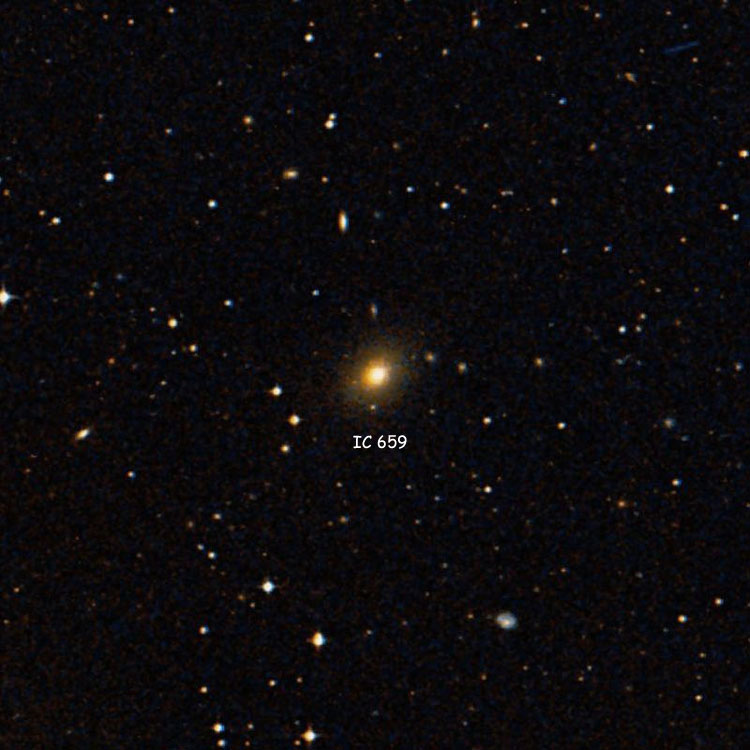
IC 660 (= PGC 33017)
Discovered (Mar 11, 1893) by Stephane Javelle (705)
A 14th-magnitude lenticular galaxy (type E/S0?) in Leo (RA 10 58 26.6, Dec +01 22 58)
Apparent size 1.1 by 0.7 arcmin.
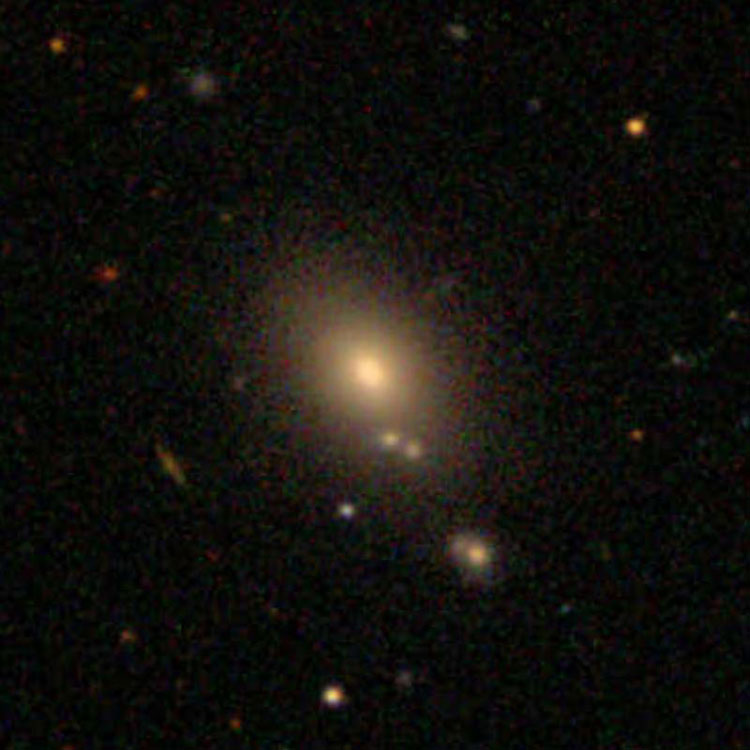
Above, a 2.4 arcmin wide closeup of IC 660
Below, a 12 arcmin wide region centered on the galaxy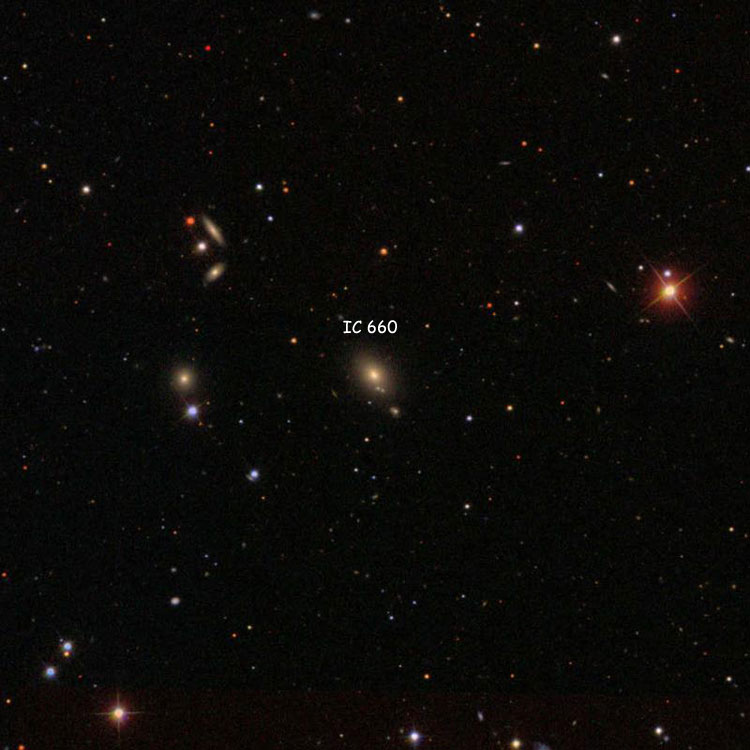
IC 661 (= PGC 33051)
Discovered (Mar 11, 1893) by Stephane Javelle (706)
A 15th-magnitude lenticular galaxy (type S0?) in Leo (RA 10 58 51.4, Dec +01 39 01)
Apparent size 0.8 by 0.65 arcmin.
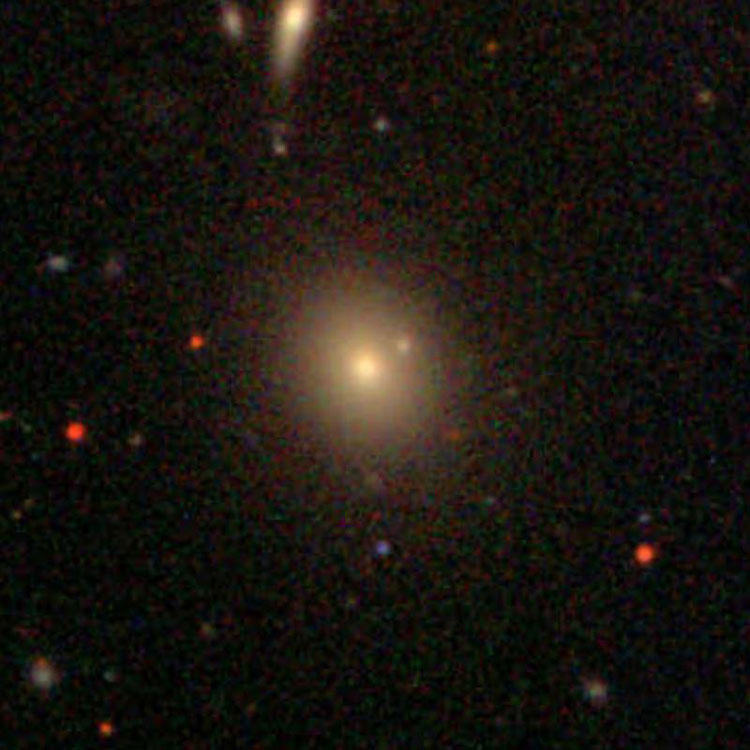
Above, a 2.4 arcmin wide closeup of IC 661
Below, a 12 arcmin wide region centered on the galaxy (also showing 8th-magnitude HD 95089)
IC 662 (= PGC 33091)
Discovered (Mar 11, 1893) by Stephane Javelle (707)
A 14th-magnitude elliptical galaxy (type E3?) in Leo (RA 10 59 20.5, Dec +01 35 56)
Apparent size 0.9 by 0.6 arcmin.

Above, a 2.4 arcmin wide closeup of IC 662
Below, a 12 arcmin wide region centered on the galaxy (also showing 8th-magnitude HD 95089)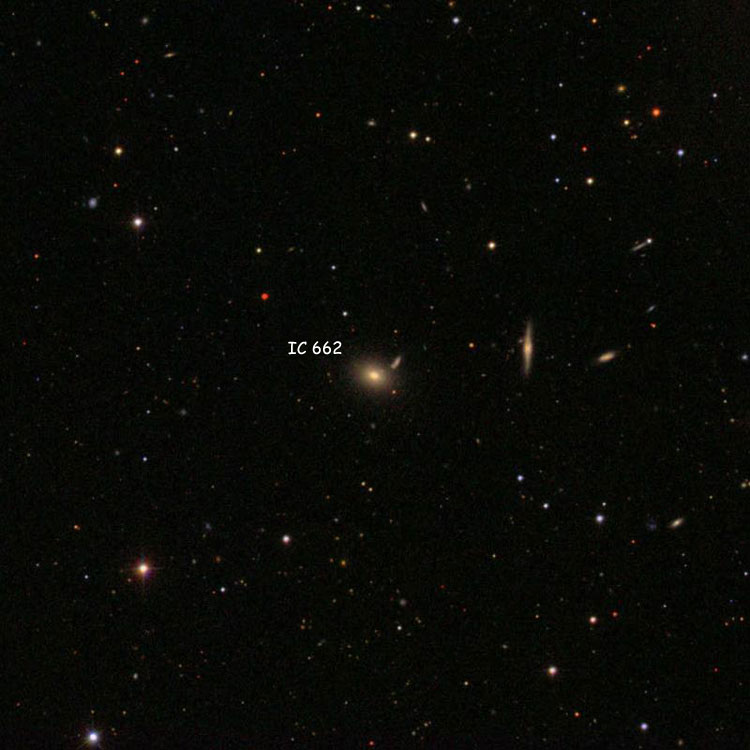
IC 663 (= PGC 33182)
Discovered (Mar 29, 1891) by Edward Swift (X-18)
A 14th-magnitude lenticular galaxy (type S0?) in Leo (RA 11 00 37.3, Dec +10 26 13)
Apparent size 0.75 by 0.45 arcmin.

Above, a 2.4 arcmin wide closeup of IC 663
Below, a 12 arcmin wide region centered on the galaxy, also showing NGC 3492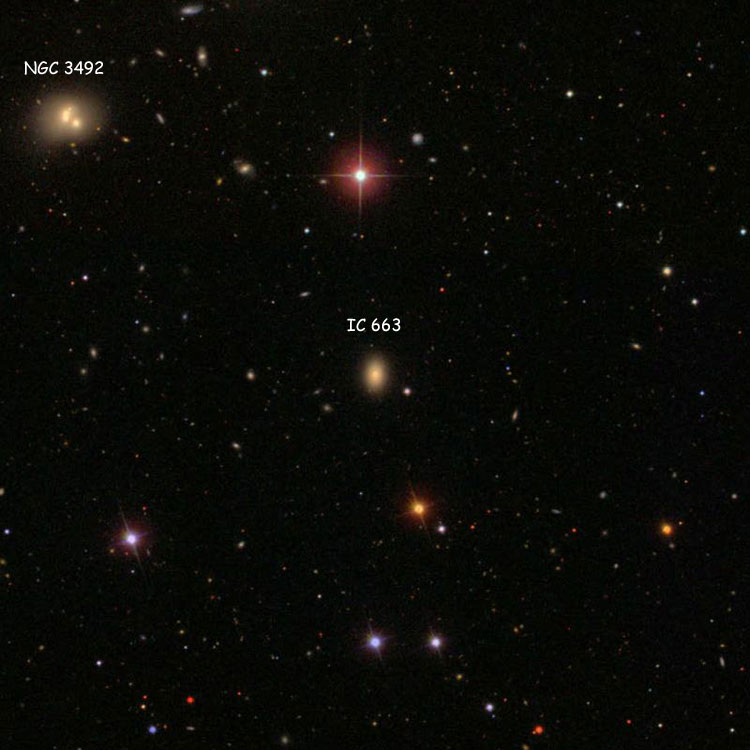
IC 664 (= PGC 33191)
Discovered (Mar 29, 1891) by Edward Swift (X-19)
A 13th-magnitude lenticular galaxy (type E/S0?) in Leo (RA 11 00 45.4, Dec +10 33 11)
Apparent size 1.8 by 1.3 arcmin.
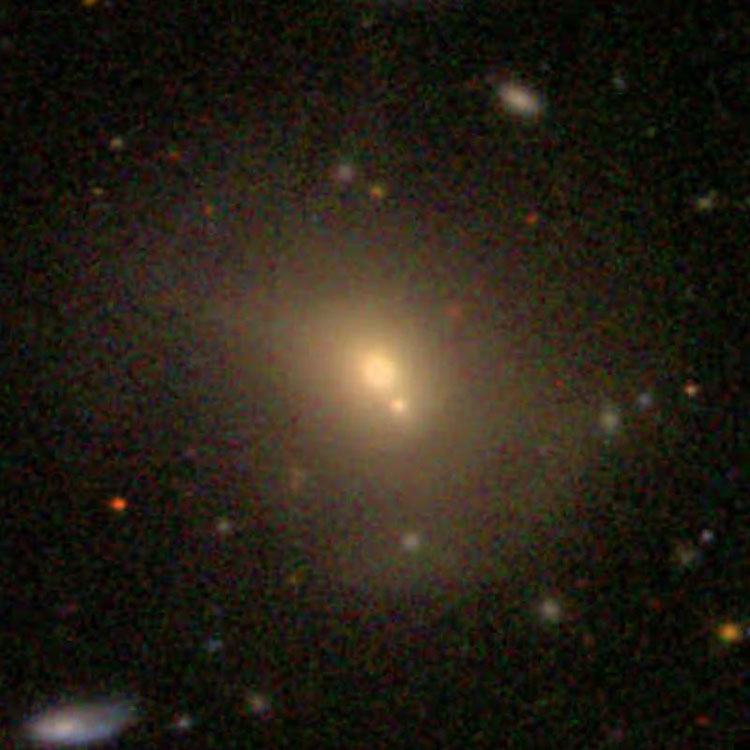
Above, a 2.4 arcmin wide closeup of IC 664
Below, a 12 arcmin wide region centered on the galaxy, also showing NGC 3492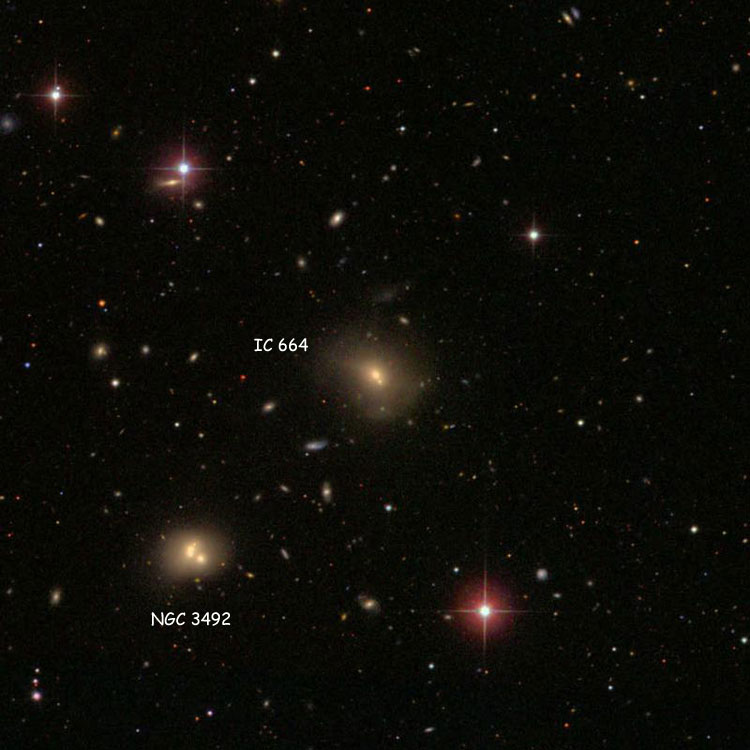
IC 665 (= PGC 170101)
Discovered (May 13, 1893) by Stephane Javelle (708)
A 15th-magnitude spiral galaxy (type Sab?) in Crater (RA 11 00 29.9, Dec -13 52 00)
Apparent size 0.8 by 0.25 arcmin.

Above, a 2.4 arcmin wide closeup of IC 665
Below, a 12 arcmin wide region centered on the galaxy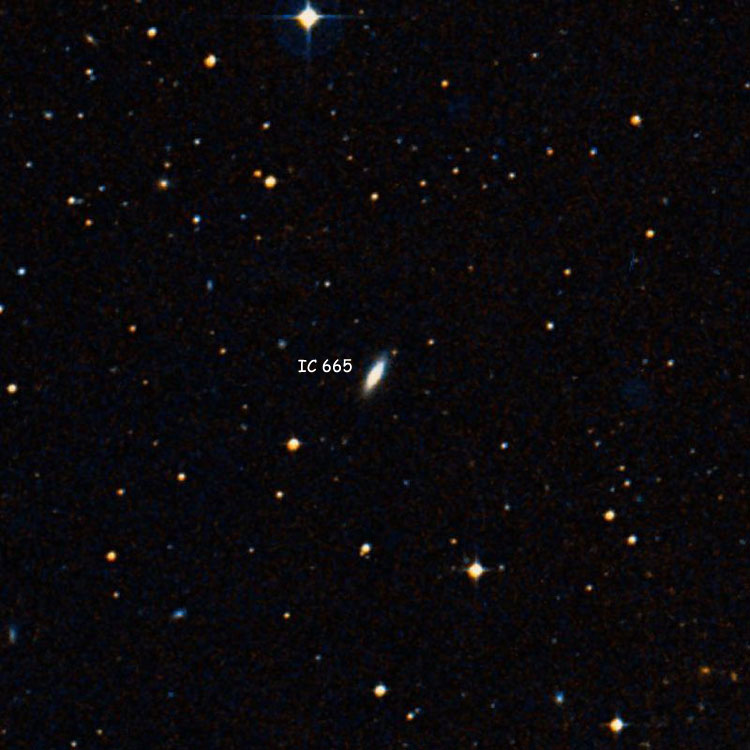
IC 666 (= PGC 33232)
Discovered (Apr 1, 1892) by Stephane Javelle (192)
A 14th-magnitude lenticular galaxy (type S0/a? pec) in Leo (RA 11 01 14.8, Dec +10 28 50)
Apparent size 0.65 by 0.45 arcmin.
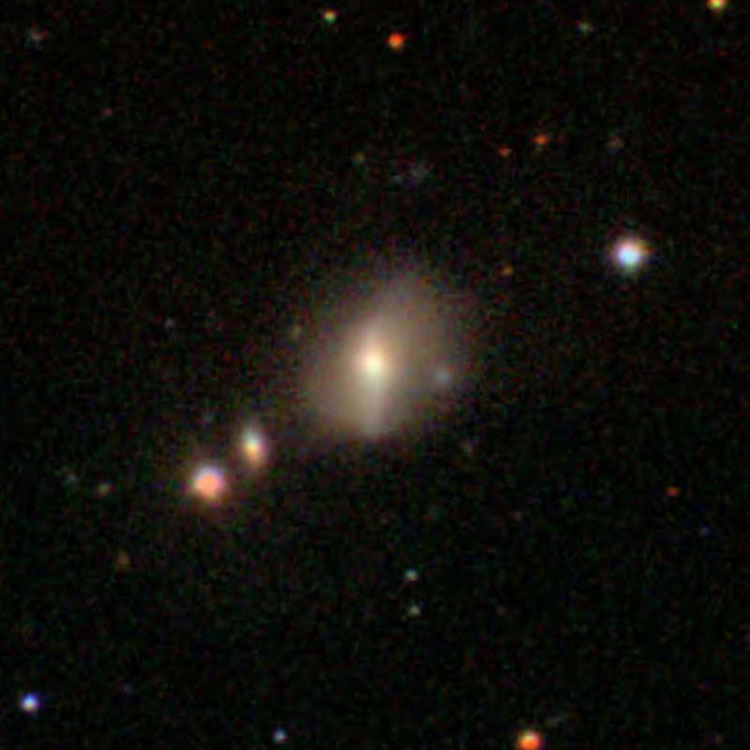
Above, a 2.4 arcmin wide closeup of IC 666
Below, a 12 arcmin wide region centered on the galaxy, also showing NGC 3492
IC 667 (= PGC 33603)
Discovered (Jan 15, 1894) by Stephane Javelle (709)
A 14th-magnitude lenticular galaxy (type S0?) in Leo (RA 11 06 36.5, Dec +15 05 19)
Apparent size 0.6 by 0.5 arcmin.

Above, a 2.4 arcmin wide closeup of IC 667
Below, a 12 arcmin wide region centered on the galaxy, also showing IC 668
IC 668 (= PGC 33613)
Discovered (Jan 15, 1894) by Stephane Javelle (710)
A 15th-magnitude spiral galaxy (type Sab?) in Leo (RA 11 06 39.5, Dec +15 02 27)
Apparent size 0.7 by 0.4 arcmin.
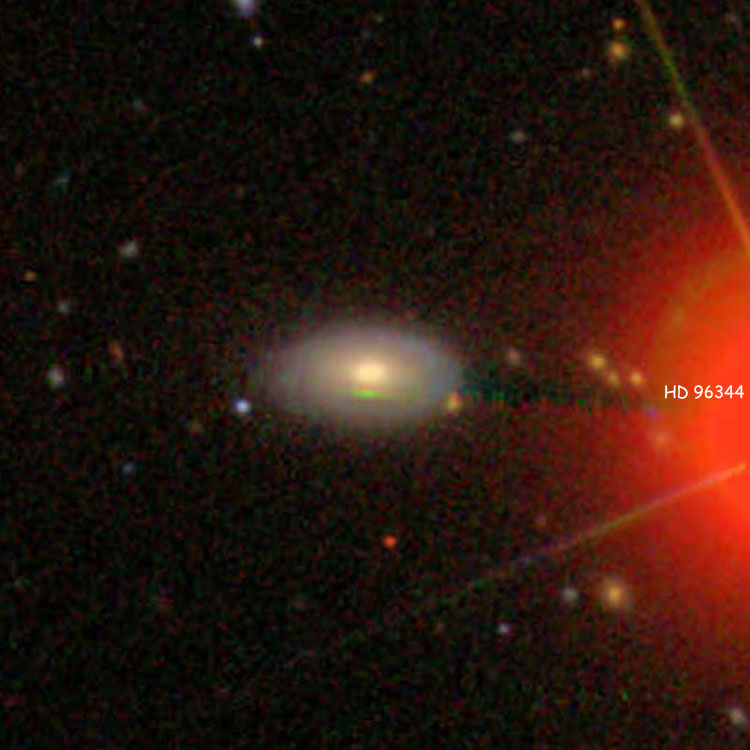
Above, a 2.4 arcmin wide closeup of IC 668, with glare from 9th-magnitude HD 96344
Below, a 12 arcmin wide region centered on the galaxy, also showing IC 667
IC 669 (= PGC 33662)
Discovered (Dec 3, 1877) by David Todd
A 13th-magnitude lenticular galaxy (type E/S0?) in Leo (RA 11 07 16.5, Dec +06 18 08)
Per Dreyer, IC 669 (Javelle #711, 1860 RA 11 00 02, NPD 82 56.5) is "pretty bright, very small, round, suddenly brighter middle". (Although the discovery was credited to Javelle by Dreyer, IC 669 was previously observed and listed by Todd as #8 in a list of nebulae discovered during his unsuccessful search for a trans-Neptunian planet, as shown above.) Apparent size 1.7 by 0.7 arcmin.

Above, a 2.4 arcmin wide closeup of IC 669
Below, a 12 arcmin wide region centered on the galaxy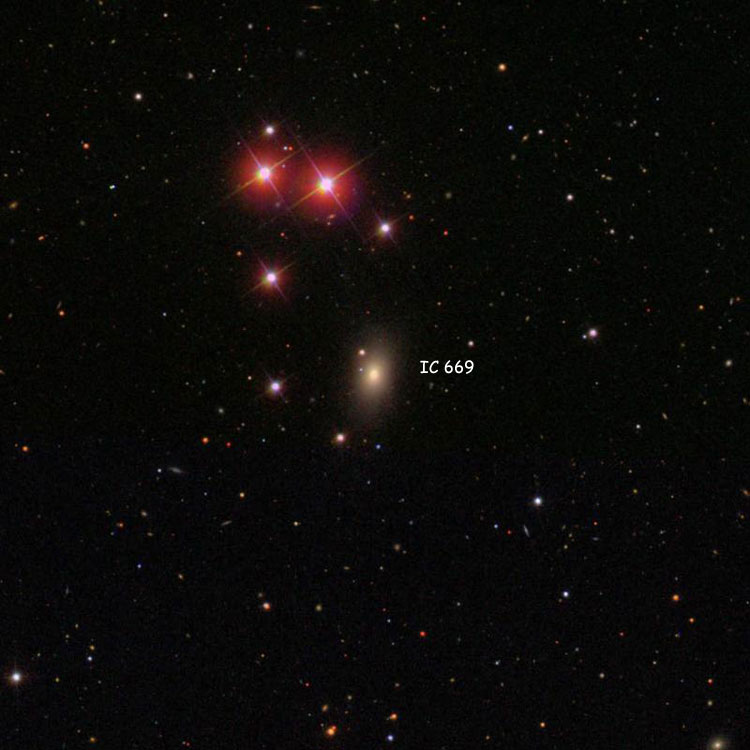
IC 670 (= PGC 33680)
Discovered (Mar 7, 1891) by Rudolf Spitaler (16)
A 13th-magnitude lenticular galaxy (type E/S0?) in Leo (RA 11 07 28.8, Dec +06 42 50)
Apparent size 1.4 by 1.0 arcmin. Per Corwin, this object could have been confused with NGC 3531, whose comparison star was misidentified by its discoverer, leading to a (wrong) position close to that of IC 670; but Spitaler realized that the description of the NGC object and its starfield were inconsistent with his #16, and correctly assumed he had found a 'nova'.
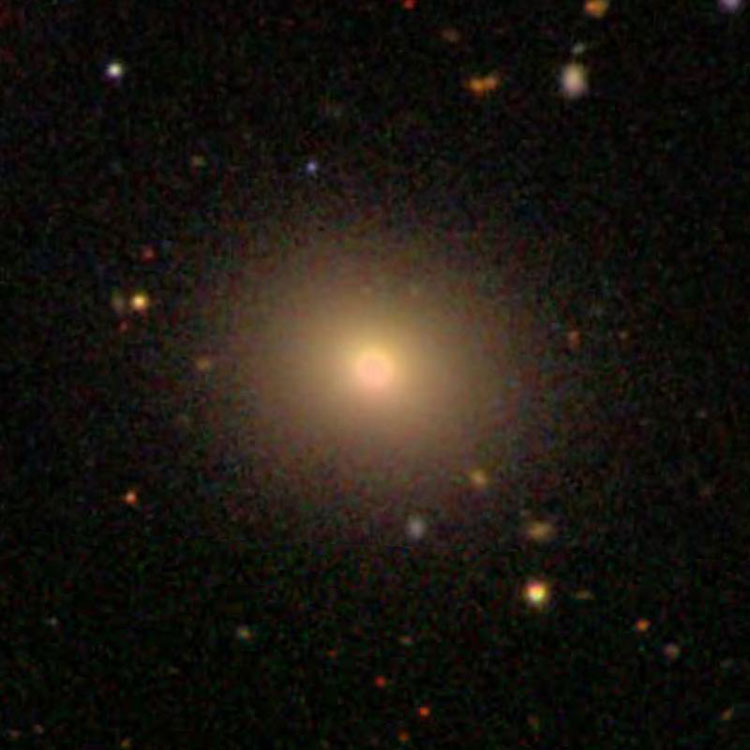
Above, a 2.4 arcmin wide closeup of IC 670
Below, a 12 arcmin wide region centered on the galaxy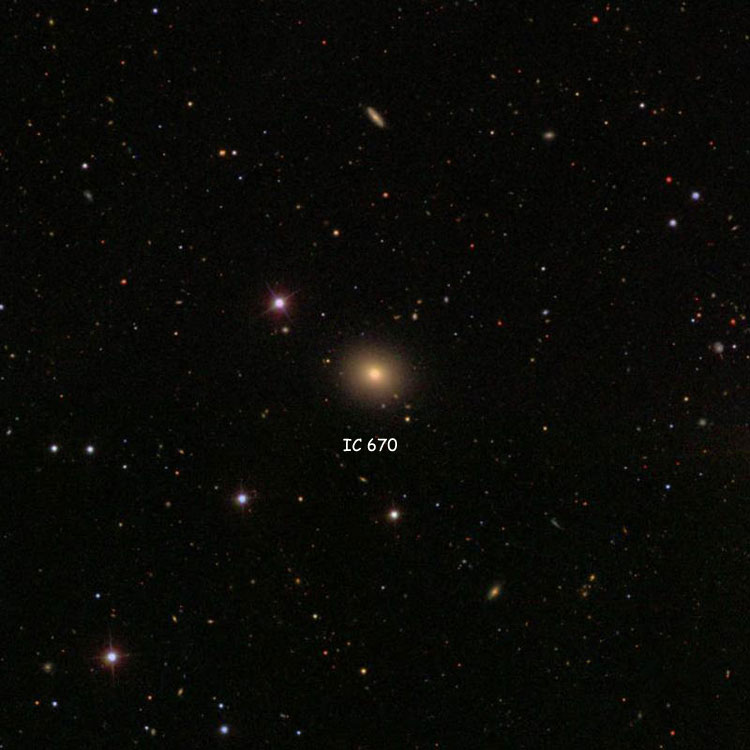
IC 671 (= PGC 33689)
Discovered (Mar 11, 1893) by Stephane Javelle (712)
A 13th-magnitude spiral galaxy (type SAB(r)bc?) in Leo (RA 11 07 31.6, Dec +00 46 57)
Apparent size 1.3 by 1.05 arcmin.

Above, a 2.4 arcmin wide closeup of IC 671
Below, a 12 arcmin wide region centered on the galaxy
IC 672 (= PGC 33725)
Discovered (Apr 19, 1892) by Stephane Javelle (193)
A 15th-magnitude lenticular galaxy (type S0/a?) in Crater (RA 11 08 03.2, Dec -12 29 04)
Apparent size 0.65 by 0.25 arcmin.
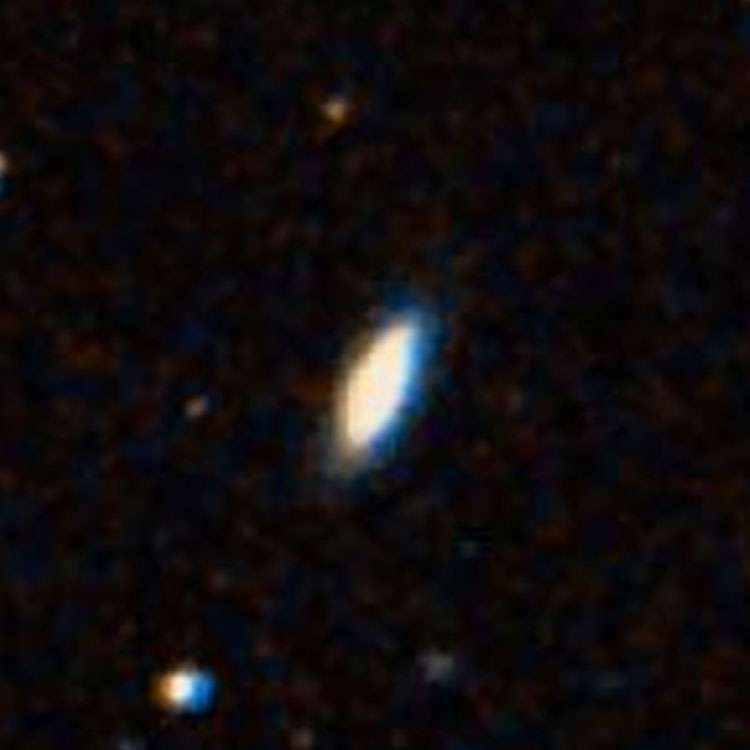
Above, a 2.4 arcmin wide closeup of IC 672
Below, a 12 arcmin wide region centered on the galaxy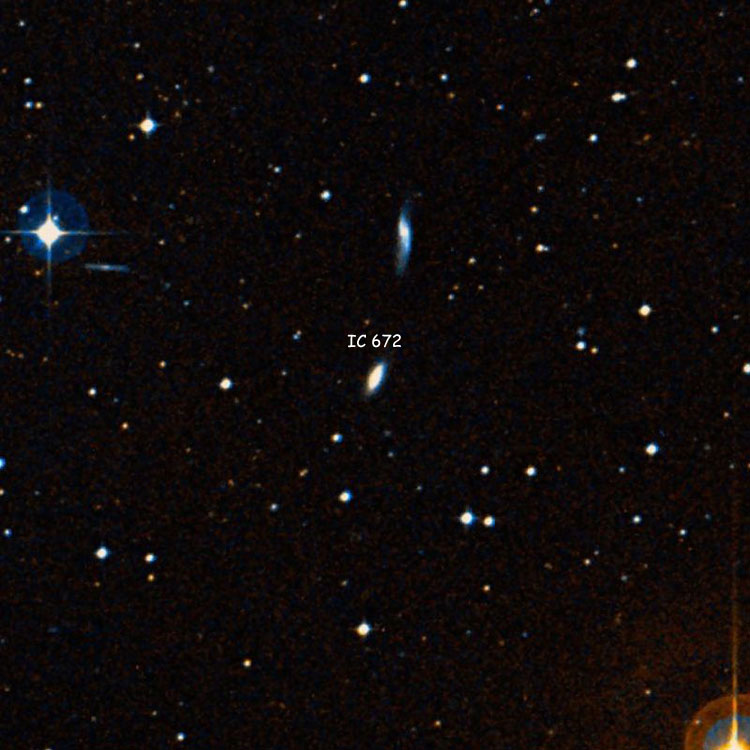
IC 673 (= PGC 33817)
Discovered (Apr 22, 1892) by Stephane Javelle (194)
A 13th-magnitude spiral galaxy (type (R')SAB(rs)c) in Leo (RA 11 09 25.3, Dec -00 05 54)
The apparent size of the outer ring is about 2.9 by 1.0 arcmin.

Above, a 3 arcmin wide closeup of IC 673
Below, a 12 arcmin wide region centered on the galaxy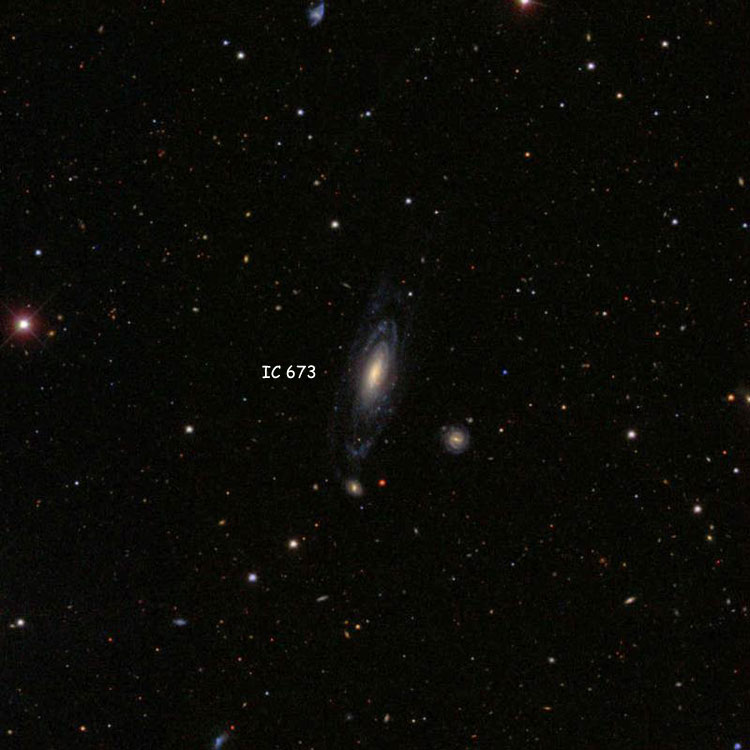
IC 674 (= PGC 33982)
Discovered (May 24, 1892) by Rudolf Spitaler (36)
A 13th-magnitude spiral galaxy (type Sab?) in Ursa Major (RA 11 11 06.4, Dec +43 37 59)
Apparent size 1.7 by 0.6 arcmin.

Above, a 2.4 arcmin wide closeup of IC 674
Below, a 12 arcmin wide region centered on the galaxy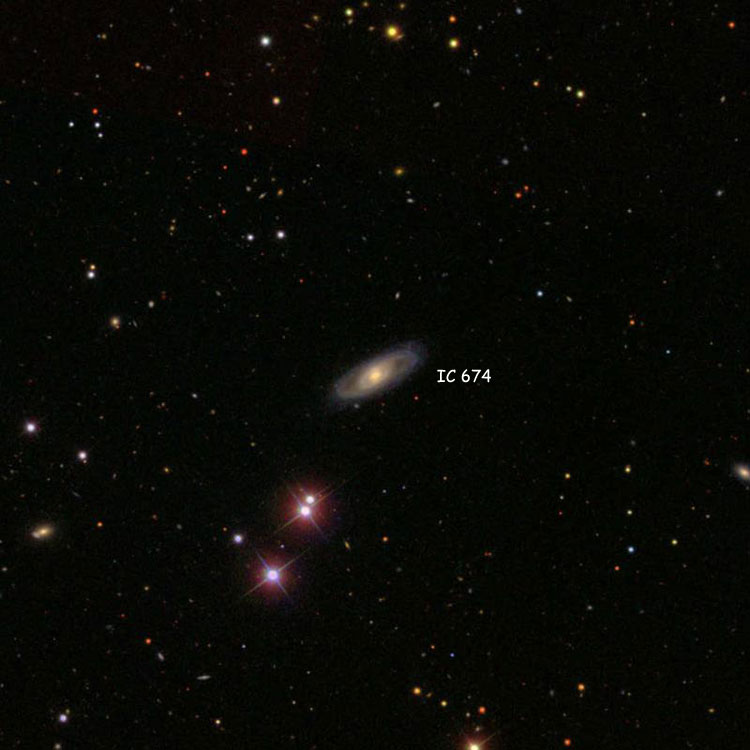
IC 675
Recorded (May 19, 1893) by Stephane Javelle
A lost or nonexistent object in Leo (RA 11 10 42.3, Dec +03 40 40)
or a 14th- and 15th-magnitude pair of stars at RA 11 10 57.4, Dec +03 35 40
Per Dreyer, IC 675 (Javelle #713, 1860 RA 11 03 29, NPD 85 33.8) is "pretty bright, pretty large, extended north-south, binuclear?". The position precesses to RA 11 10 42.3, Dec +03 40 40 (whence the position above), but there is nothing there or near there. However, there is a pair of stars that would match the description if mistaken for a nebular object, at the second position listed above; and per Corwin that might be a reasonable identification if Javelle made a mistake in his comparison star. However, the star that would have to be the actual comparison star is considerably fainter than most of Javelle's comparison stars, and would still result in an error of an arcmin in the declination. So although it is possible that the pair of stars is Javelle's #713, it seems at least as likely that the object is lost.
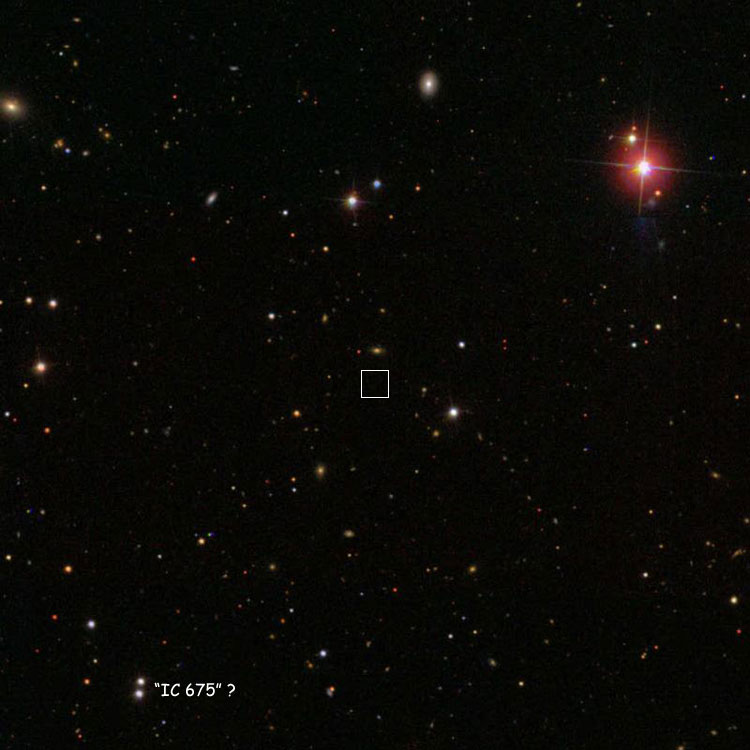
Above, a 12 arcmin wide region centered on Javelle's position, also showing the pair of stars noted above
IC 676 (= PGC 34107)
Discovered (Apr 8, 1891) by Edward Swift (X-20)
A 12th-magnitude lenticular galaxy (type (R)SB0+(r)) in Leo (RA 11 12 39.8, Dec +09 03 21)
Apparent size 2.1 by 1.3 arcmin.
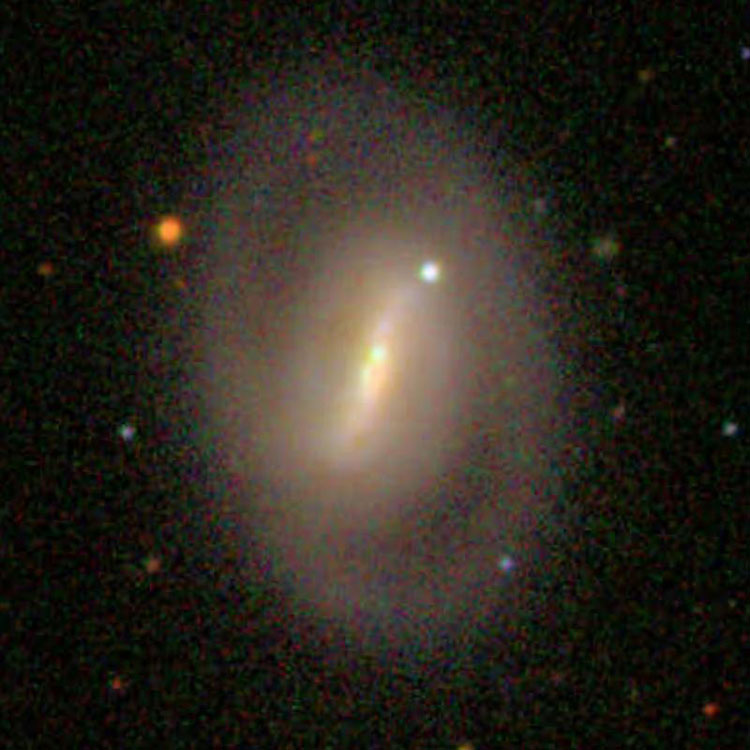
Above, a 2.4 arcmin wide closeup of IC 676
Below, a 12 arcmin wide region centered on the galaxy
IC 677 (= PGC 34211)
Discovered (Apr 1, 1892) by Stephane Javelle (195)
A 13th-magnitude spiral galaxy (type Sbc?) in Leo (RA 11 13 56.6, Dec +12 18 04)
Apparent size 1.45 by 0.65 arcmin.
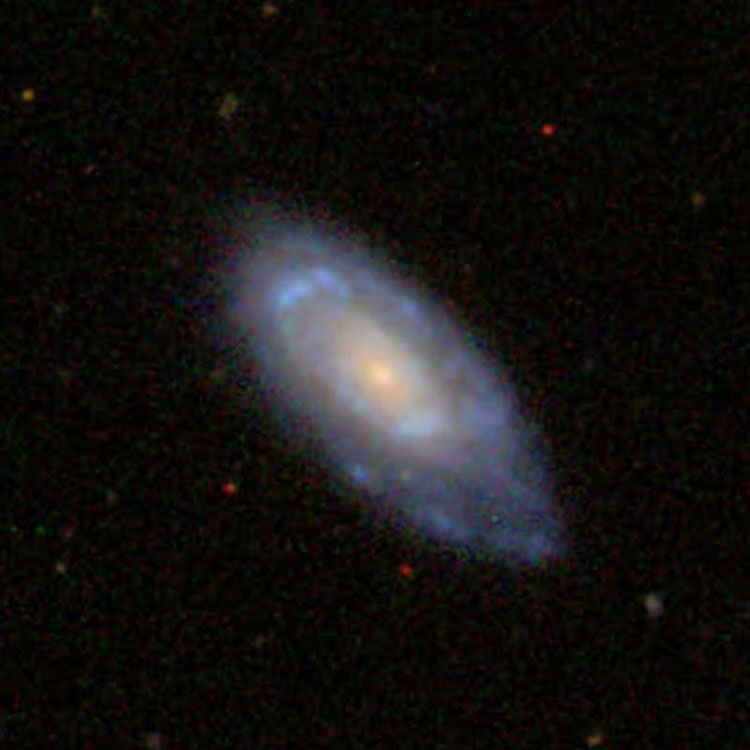
Above, a 2.4 arcmin wide closeup of IC 677
Below, a 12 arcmin wide region centered on the galaxy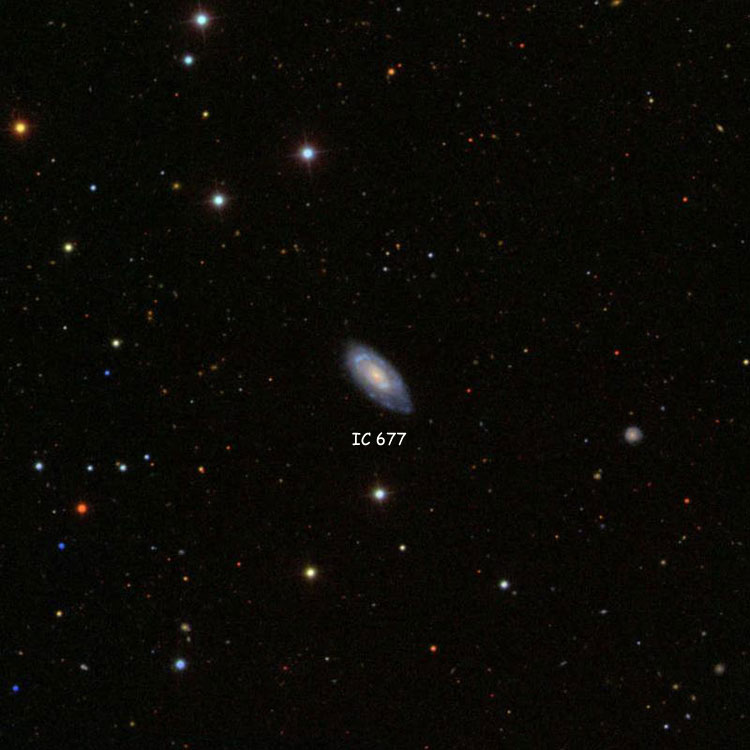
IC 678 (= PGC 34222)
Discovered (Apr 13, 1893) by Stephane Javelle (714)
A 14th-magnitude elliptical galaxy (type E4?) in Leo (RA 11 14 06.3, Dec +06 34 38)
Apparent size 1.1 by 0.7 arcmin.

Above, a 2.4 arcmin wide closeup of IC 678
Below, a 12 arcmin wide region centered on the galaxy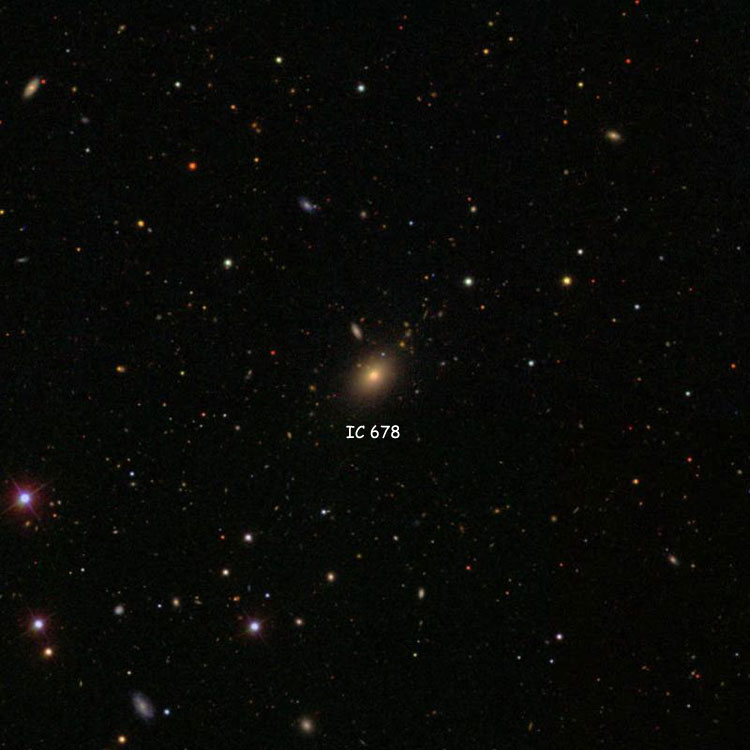
IC 679 (= PGC 170124)
Discovered (May 13, 1893) by Stephane Javelle (715)
A 15th-magnitude spiral galaxy (type Sa?) in Crater (RA 11 16 36.6, Dec -13 58 19)
Apparent size 0.9 by 0.6 arcmin.
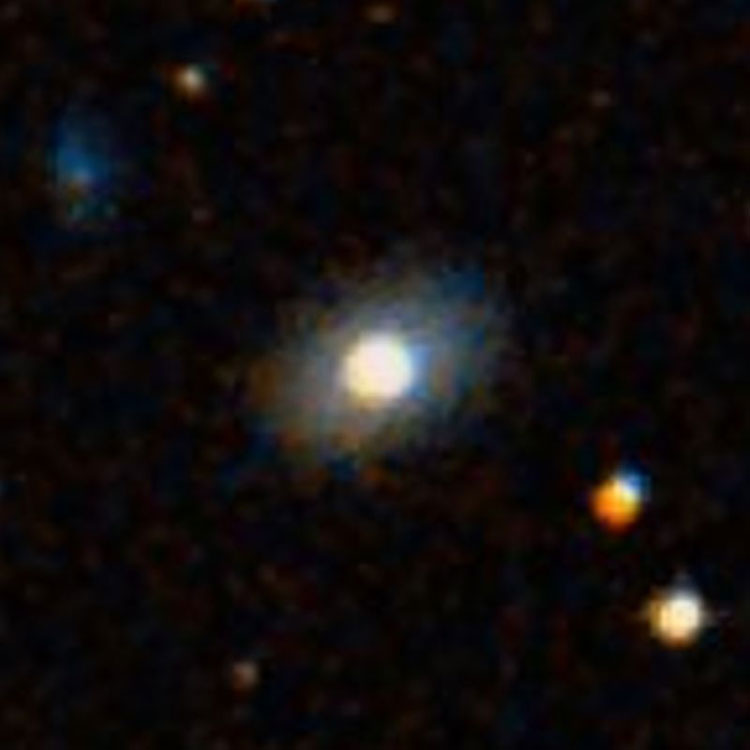
Above, a 2.4 arcmin wide closeup of IC 679
Below, a 12 arcmin wide region centered on the galaxy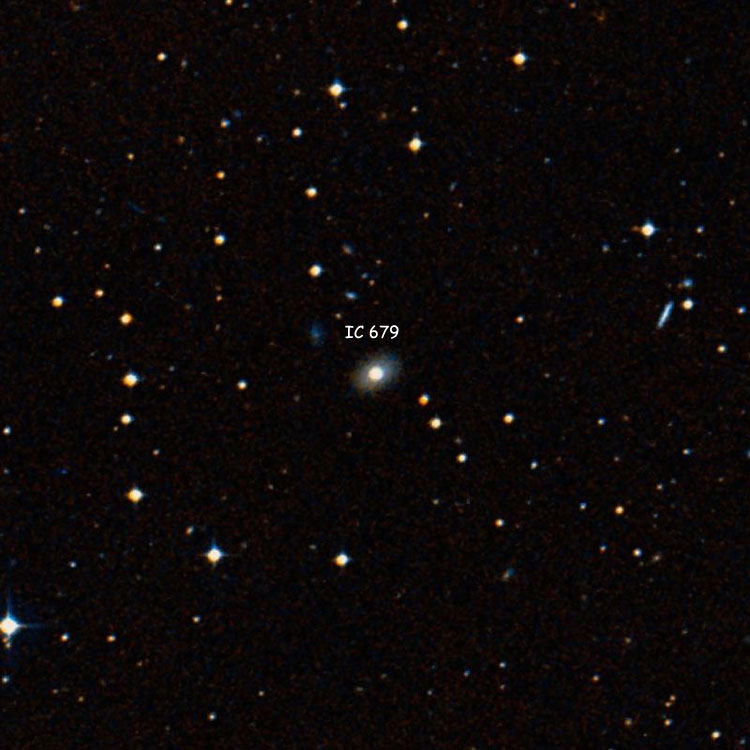
IC 680 (= PGC 34520)
Discovered (Apr 7, 1893) by Stephane Javelle (716)
A 14th-magnitude spiral galaxy (type (R')SB(rs)a?) in Leo (RA 11 17 54.6, Dec -01 56 50)
Apparent size 1.2 by 0.7 arcmin.
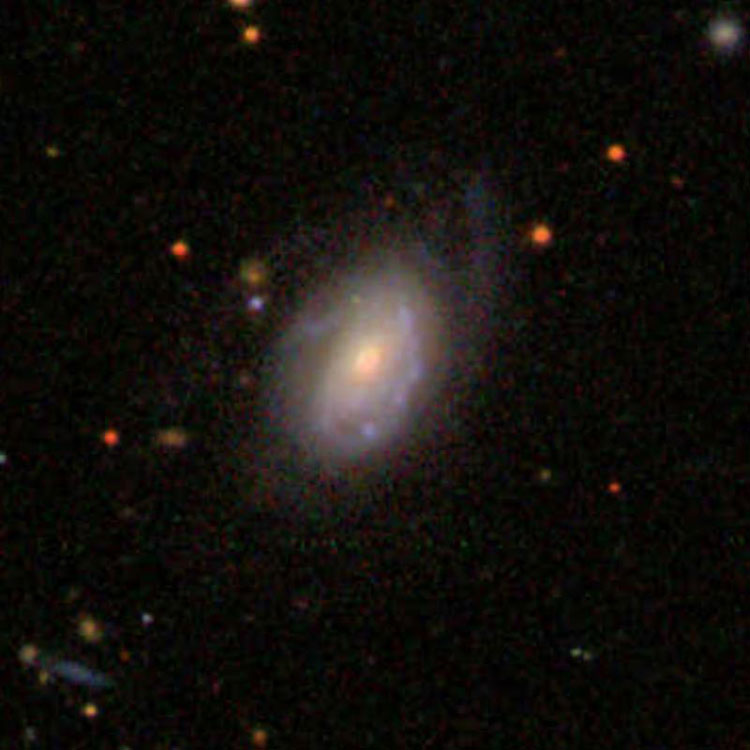
Above, a 2.4 arcmin wide closeup of IC 680
Below, a 12 arcmin wide region centered on the galaxy
IC 681 (= PGC 34572)
Discovered (Apr 19, 1892) by Stephane Javelle (196)
A 14th-magnitude spiral galaxy (type Sc?) in Crater (RA 11 18 31.9, Dec -12 08 26)
Apparent size 0.95 by 0.55 arcmin.
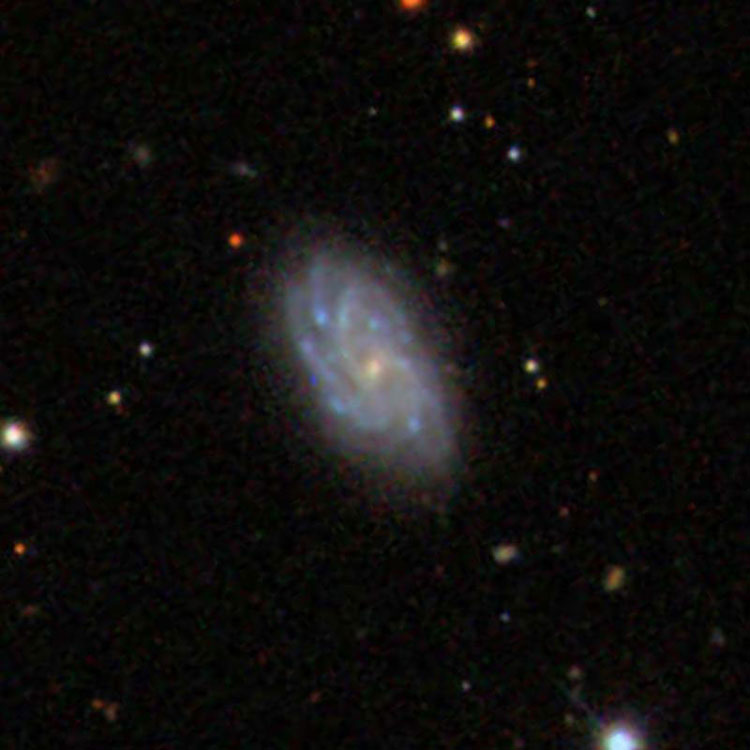
Above, a 2.4 arcmin wide closeup of IC 681
Below, a 12 arcmin wide region centered on the galaxy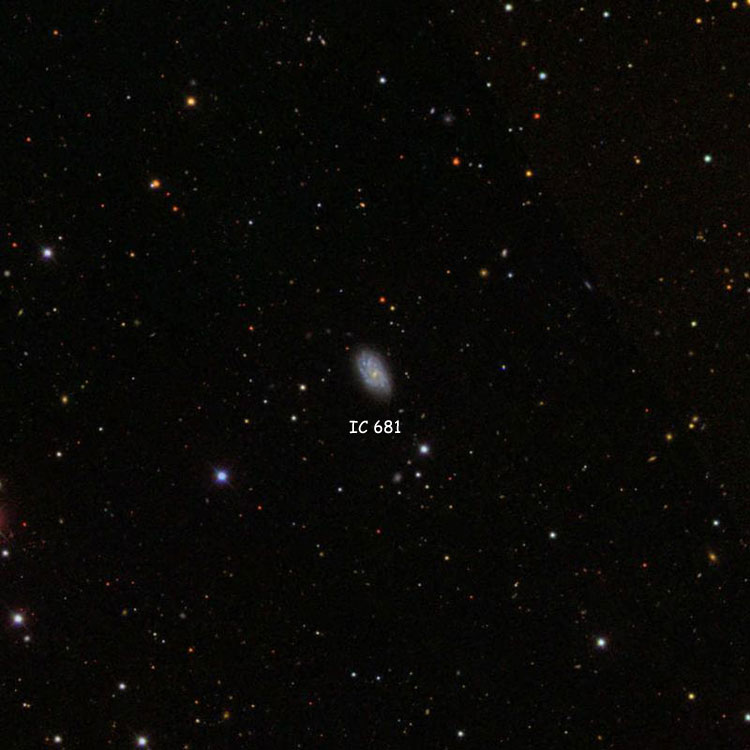
IC 682 (= NGC 3649 = PGC 34883)
Discovered (Feb 23, 1784) by William Herschel (and later listed as NGC 3649)
Discovered (Apr 22, 1889) by Lewis Swift (and later listed as IC 682)
A 14th-magnitude spiral galaxy (type SB(rs)a) in Leo (RA 11 22 14.8, Dec +20 12 30)
Per Dreyer, IC 682 (Swift list VIII (#56), 1860 RA 11 13 50, NPD 69 00.9) is "extremely faint, extremely small, round, very faint star close on northwest". The position precesses to RA 11 21 13.2, Dec +20 13 08, but there is nothing there. However, as noted by Corwin, assuming a (fairly common) 1 minute error in the right ascension puts the position right on the galaxy listed above, and the description fits it, so the identification seems reasonably certain, and is generally accepted. (Swift's description of the star field doesn't fit, but that isn't unusual for him, since he used a very low magnification and "close" doesn't mean what it might for another observer.) The double listing is undoubtedly due to the (presumed) error in Swift's position; see NGC 3649 for anything else.
IC 683 (= PGC 34807)
Discovered (Apr 14, 1888) by Guillaume Bigourdan (162)
A 14th-magnitude elliptical galaxy (type E3?) in Leo (RA 11 21 31.8, Dec +02 45 06)
Per Dreyer, IC 683 (Bigourdan #162, 1860 RA 11 14 19, NPD 86 28) is a "nebulous object of 13.5 magnitude". The position precesses to RA 11 21 31.2, Dec +02 46 01, about an arcmin north of the galaxy listed above, so the identification is essentially certain. Despite that, IC 683 is sometimes misidentified as the much fainter galaxy (PGC 34793) to its west, which see immediately below. Apparent size 0.9 by 0.65 arcmin.
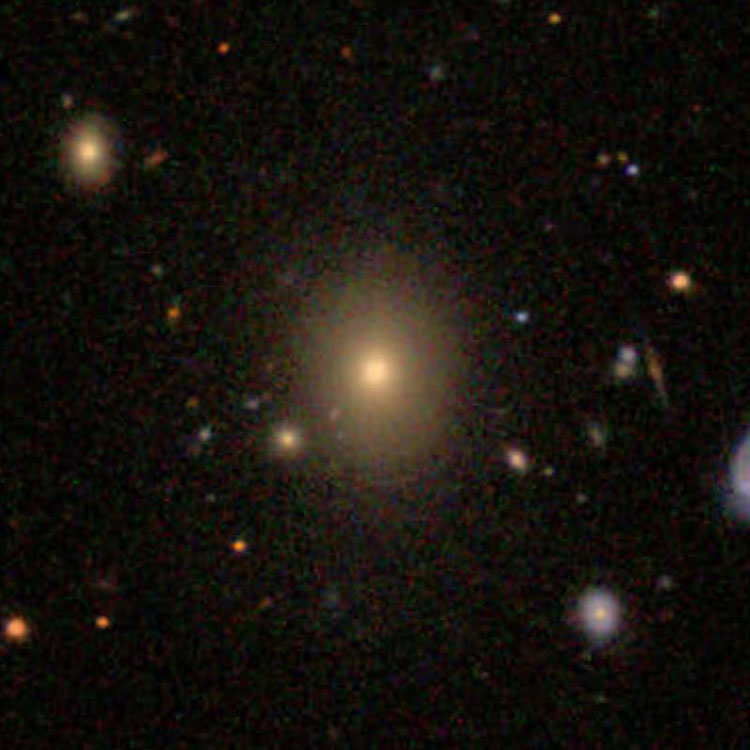
Above, a 2.4 arcmin wide closeup of IC 683
Below, a 12 arcmin wide region centered on the galaxy, also showing NGC 3644 and PGC 34793
PGC 34793 (not = IC 683)
Not an IC object but listed here since sometimes misidentified as IC 683
A 16th-magnitude spiral galaxy (type Sbc?) in Leo (RA 11 21 26.7, Dec +02 44 48)
Apparent size 0.45 by 0.25 arcmin.
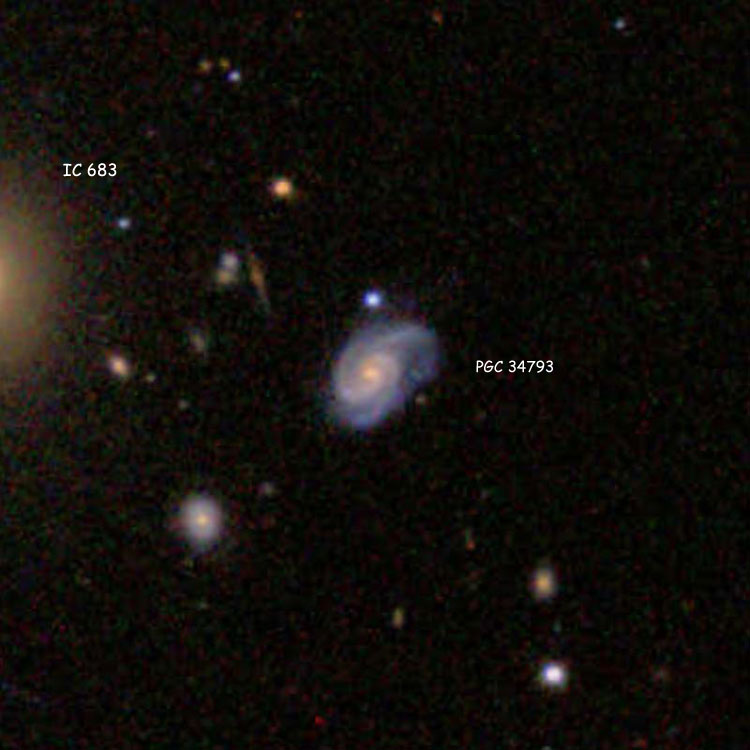
Above, a 2.4 arcmin wide closeup of PGC 34793; see IC 683 for a wide-field view
IC 684 (= NGC 3644 = PGC 34814)
Discovered (Mar 22, 1865) by Albert Marth (and later listed as NGC 3644)
Discovered (Apr 14, 1888) by Guillaume Bigourdan (and later listed as IC 684)
A 14th-magnitude spiral galaxy (type (R')SBa pec?) in Leo (RA 11 21 32.8, Dec +02 48 37)
Per Dreyer, IC 684 (Bigourdan #163, 1860 RA 11 14 22, NPD 86 24) is "faint, small, double star 0.5 arcmin to southwest". The position precesses to RA 11 21 34.2, Dec +02 50 01, a little over an arcmin north of the galaxy listed above (an error similar to that for his #162, observed the same night), and there is a star (albeit not a double one) in the correct position, so the identification is certain. Bigourdan's position is essentially the same as that measured by Marth for NGC 3644 (which see for anything else), but Bigourdan misidentified another object as NGC 3644, leading him and Dreyer to presume that his #163 must be a new object; whence the duplicate listing.
IC 685 (= PGC 34871)
Discovered (Apr 11, 1888) by Lewis Swift (VII-16)
A 15th-magnitude elliptical galaxy (type E5?) in Leo (RA 11 22 06.6, Dec +17 45 10)
Apparent size 0.7 by 0.35 arcmin.

Above, a 2.4 arcmin wide closeup of IC 685
Below, a 12 arcmin wide region centered on the galaxy
IC 686 (= PGC 34950)
Discovered (Apr 13, 1893) by Stephane Javelle (717)
A 15th-magnitude spiral galaxy (type Sbc?) in Leo (RA 11 23 05.2, Dec +05 38 39)
Apparent size 0.45 by 0.2 arcmin.
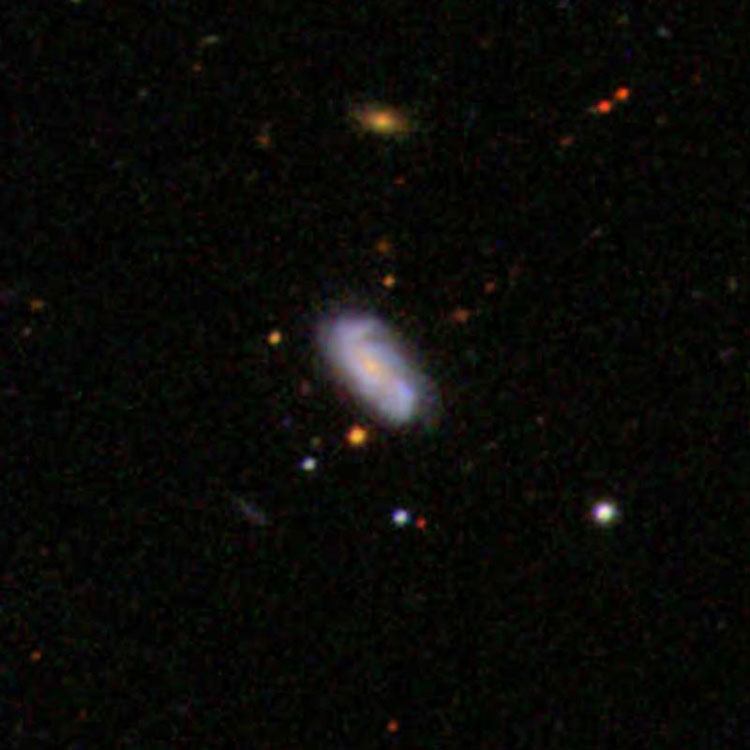
Above, a 2.4 arcmin wide closeup of IC 686
Below, a 12 arcmin wide region centered on the galaxy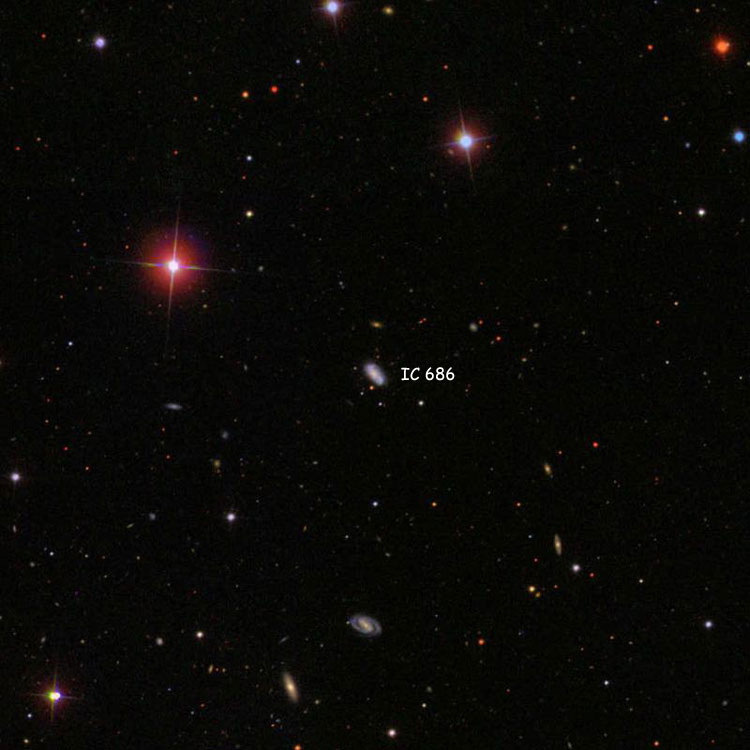
IC 687 (= PGC 35029)
Discovered (May 11, 1890) by Lewis Swift (IX-26)
A 14th-magnitude lenticular galaxy (type E/S0?) in Ursa Major (RA 11 24 17.3, Dec +47 50 50)
Apparent size 0.95 by 0.95 arcmin.

Above, a 2.4 arcmin wide closeup of IC 687
Below, a 12 arcmin wide region centered on the galaxy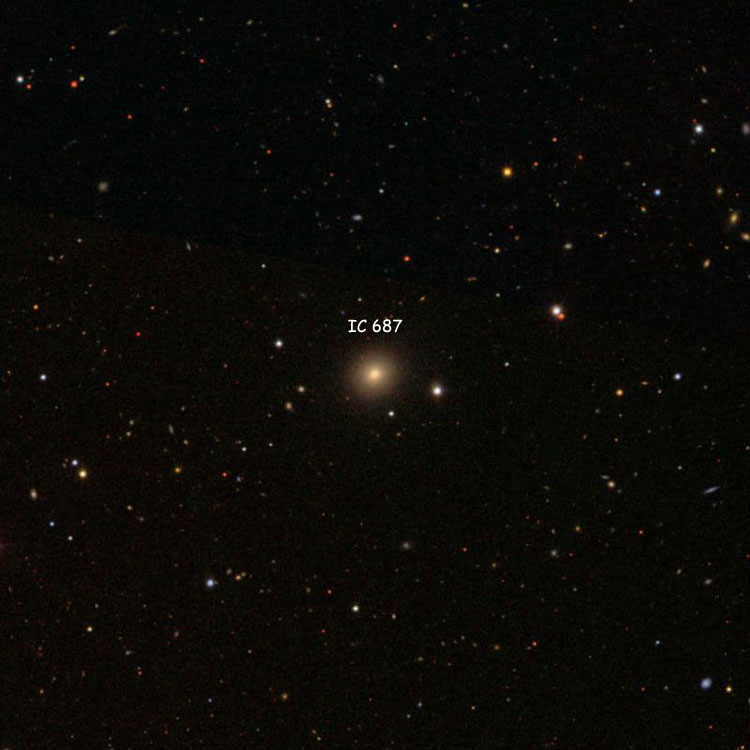
IC 688 (= PGC 156572)
Discovered (Jan 9, 1889) by Ormond Stone
A 15th-magnitude spiral galaxy (type Sab?) in Crater (RA 11 23 40.2, Dec -09 47 44)
Per Dreyer, IC 688 (Ormond Stone (#418), 1860 RA 11 16 36, NPD 99 01.6) is "extremely faint, very small, round". The position precesses to RA 11 23 40.9, Dec -09 47 40, right on the galaxy, so the identification is certain. (A modern misidentification with J2000 112424.2-094735, which lies about 3/4 of a minute of time to the east, was not corrected until 2005 and is still found in some places, so that object is discussed immediately below.) Apparent size 0.75 by 0.45 arcmin.

Above, a 2.4 arcmin wide closeup of IC 688
Below, a 12 arcmin wide region centered on the galaxy
J2000 112424.2-094735 (not = IC 688)
Not an IC object but listed here since sometimes misidentified as IC 688
An 18th-magnitude elliptical galaxy (type dE4?) in Crater (RA 11 24 24.2, Dec -09 47 35)
Apparent size 0.3 by 0.18 arcmin. Nothing else known, but the galaxy's appearance is suggestive of a dwarf elliptical, whence the type listed above.
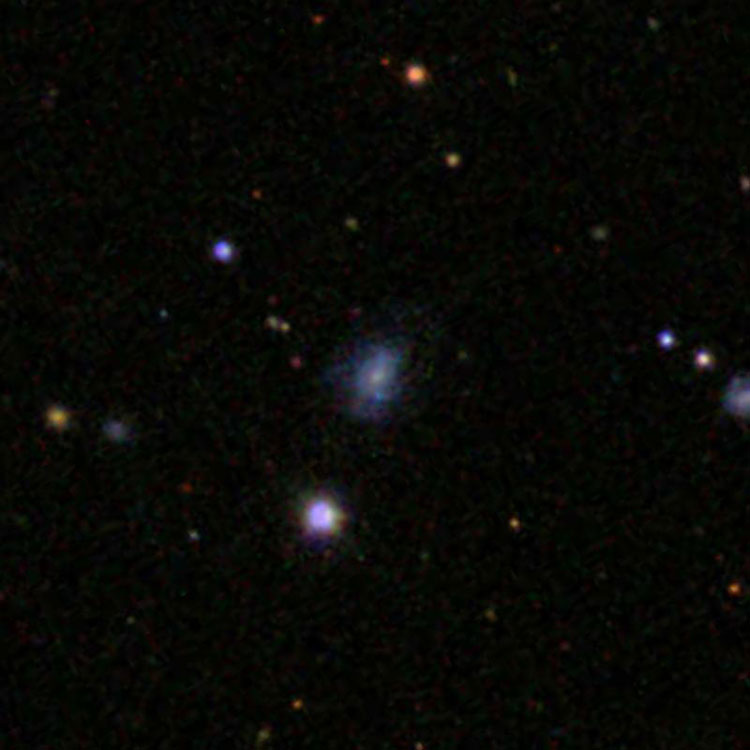
Above, a 2.4 arcmin wide closeup of the galaxy
Below, a 12 arcmin wide region centered on the galaxy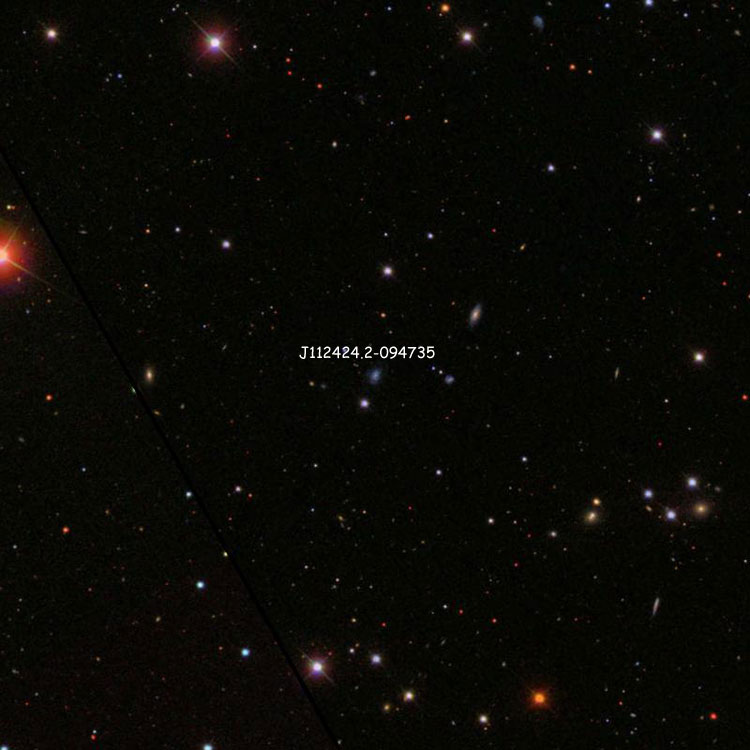
IC 689 (= NGC 3661 = PGC 34986)
Discovered (Mar 27, 1786) by William Herschel (and later listed as NGC 3661)
Also observed (Mar 16, 1836) by John Herschel (and later listed as NGC 3661)
Discovered (Jan 1, 1889) by Ormond Stone (and later listed as IC 689)
A magnitude 13.1 lenticular galaxy (type SA0(r)a?) in Crater (RA 11 23 38.4, Dec -13 49 52)
Historical Identification: Per Dreyer, IC 689 (Ormond Stone (#421), 1860 RA 11 16 36, NPD 103 03.7) is "extremely faint, very small, round, diffuse". The position precesses to RA 11 23 38.5, Dec -13 49 46, right on the galaxy, the description is a reasonable fit and there is nothing else nearby so the identification is certain.
Discovery Notes: The duplicate listing must have been a simple oversight by Stone and Dreyer, as Dreyer's positions for IC 689 and NGC 3661 are essentially identical.
Physical Information: Given the duplicate listing, see NGC 3661 for anything else.
IC 690 (= PGC 170138)
Discovered (May 13, 1893) by Stephane Javelle (718)
A 15th-magnitude lenticular galaxy (type S0/a?) in Crater (RA 11 24 20.6, Dec -08 20 31)
Apparent size 0.95 by 0.35 arcmin.
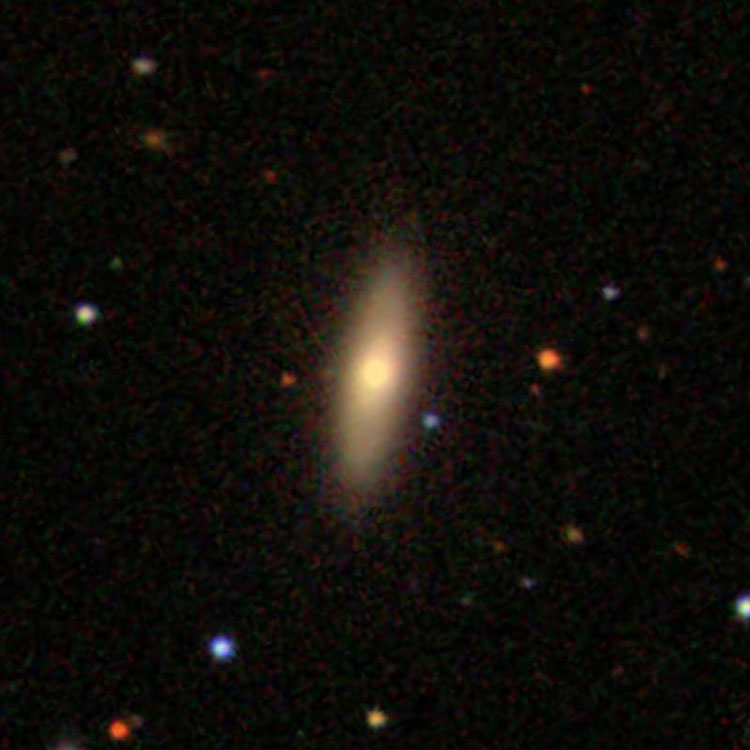
Above, a 2.4 arcmin wide closeup of IC 690
Below, a 12 arcmin wide region centered on the galaxy
IC 691 (= PGC 35206)
Discovered (Apr 17, 1888) by Lewis Swift (VII-17)
A 14th-magnitude spiral galaxy (type Sa? pec) in Ursa Major (RA 11 26 44.4, Dec +59 09 20)
Apparent size 1.0 by 0.55 arcmin.

Above, a 2.4 arcmin wide closeup of IC 691
Below, a 12 arcmin wide region centered on the galaxy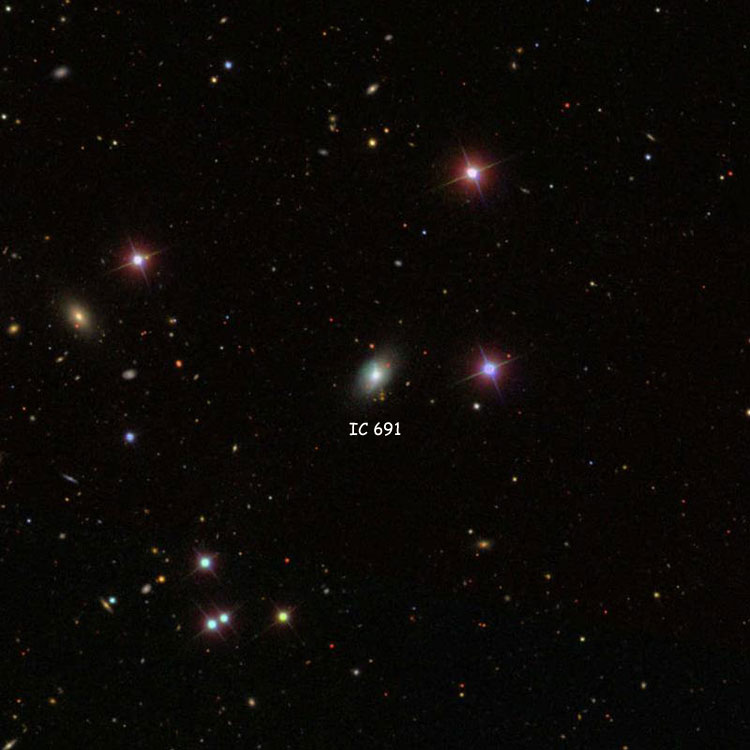
IC 692 (= PGC 35151)
Discovered (Mar 31, 1892) by Rudolf Spitaler (37)
A 14th-magnitiude irregular galaxy (type IB?) in Leo (RA 11 25 53.6, Dec +09 59 14)
Apparent size 0.8 by 0.55 arcmin.
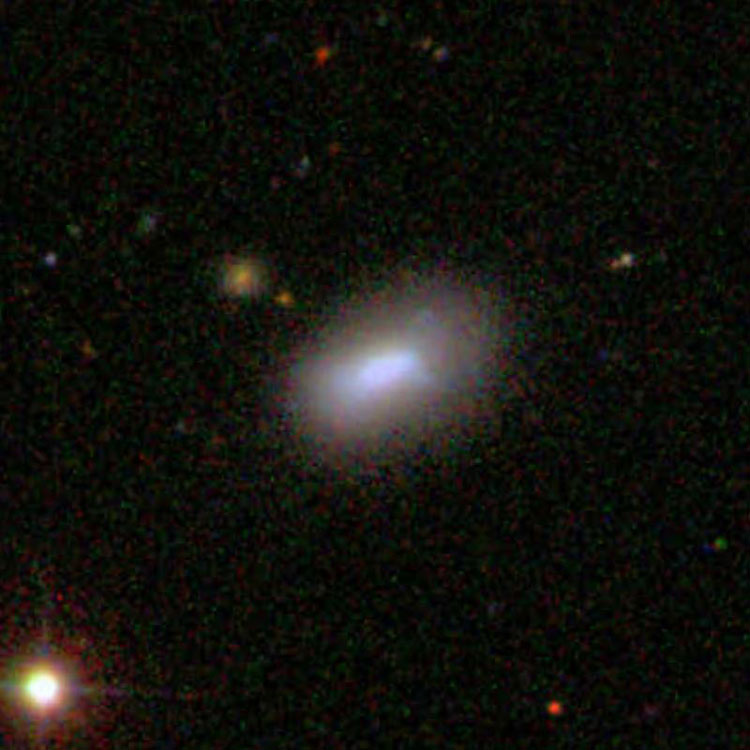
Above, a 2.4 arcmin wide closeup of IC 692
Below, a 12 arcmin wide region centered on the galaxy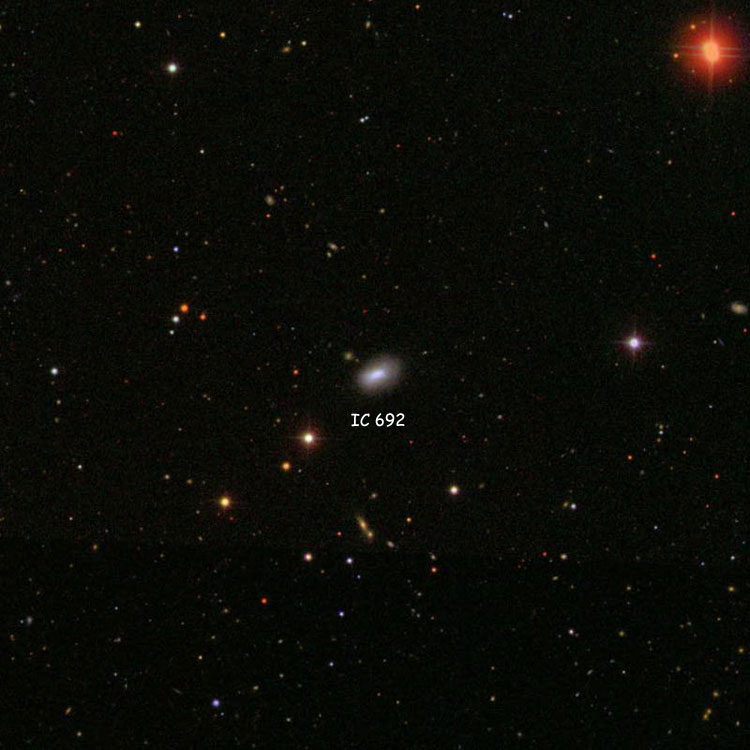
IC 693 (= PGC 35208)
Discovered (Apr 18, 1893) by Stephane Javelle (719)
A 15th-magnitude spiral galaxy (type Sab?) in Leo (RA 11 26 48.6, Dec -05 00 16)
Apparent size 0.9 by 0.5 arcmin.

Above, a 2.4 arcmin wide closeup of IC 693
Below, a 12 arcmin wide region centered on the galaxy
IC 694 (= PGC 35325 and not the western component of NGC 3690)
(with NGC 3690, perhaps part of Arp 299)
Discovered (Jan 27, 1852) by Bindon Stoney
Also observed (Apr 18, 1892) by Lewis Swift
A magnitude 15.0 elliptical galaxy (type dE1) in Ursa Major (RA 11 28 27.3, Dec +58 34 43)
Historical Identification and Modern Misidentification: Per Dreyer, IC 694 (3rd Lord Rosse, Swift (list X), 1860 RA 11 20 44, NPD 30 40) is "very small, forms double nebula with I 247", (WH) I 247 being NGC 3690. The position precesses to RA 11 28 41.9, Dec +58 33 47, which is 14 seconds of time east of NGC 3690, and therefore not in agreement with Dreyer's description of the object as a companion of the larger galaxy. But per Corwin there is a simple solution to the problem � just assume that the position of IC 694 was not measured relative to nearby stars, but relative to NGC 3690. For instance, in Stoney's observation of NGC 3690 he noted that it had an appendage about a diameter (of the galaxy) to its northwest, which is undoubtedly the galaxy listed above. Similarly, if we compare the NGC position for NGC 3690 to the IC position for IC 694, we find that IC 694 is about an arcmin north and a second of time west of the larger galaxy, which is essentially the location of PGC 35325, and makes its identification as IC 694 certain (in other words, each galaxy's position was east of its actual position, but their relative positions were accurate). In fact, its historical identification is not the problem with this entry. Instead, it is an unfathomable misidentification of IC 694 as being part of NGC 3690 itself. (Since Dreyer, Lord Rosse and Swift all specify that IC 694 is a companion of the larger galaxy, it cannot be part of it.) As a result, many references (such as this entry) that correctly specify the identity of IC 694 include a warning that it is not the same as either component of NGC 3690, but merely its apparent companion; but of course that warning is absent from all references (such as LEDA) that misidentify the galaxy.
Discovery Notes: Although Dreyer credits the discovery to William Parsons, 3rd Earl of Rosse, he notes that many of Rosse's nebular discoveries were actually made by one of his assistants, in this case Bindon Stoney. Also, although Dreyer credits Swift's list X for a later observation, Swift's observation was published in a completely separate list (Steinicke's S333). However, it is possible that Swift informed Dreyer of his observation of the nebula simultaneously with a list of the objects in his List X, and Dreyer therefore assumed that it could be found there (that sort of thing is known to have happened for many of the objects inadvertently left out of Swift's list VI, which were finally published in his list IX).
Arp Atlas Usage: It is possible (but not necessarily probable) that IC 694 is part of Arp 299, as shown in the title for this entry. For a discussion of why we cannot know whether IC 694 is part of the Arp object, see NGC 3690.
Physical Information: Based on a recessional velocity of 3955 km/sec (and H0 = 70 km/sec/Mpc), IC 694 is about 185 million light years away, or 40 to 45 million light years beyond NGC 6930, and as a result is only an optical double with its apparent companion. Given that and its apparent size of about 0.25 by 0.22 arcmin (from the images below), is it about 12 to 14 thousand light years across, whence its type being listed as a dwarf elliptical. NED lists it as a starburst galaxy, but in the HST image below it appears to be a perfectly normal galaxy for its type. Per Corwin the error was copied from the UGC and being a direct quote will never be corrected, but it is an error, and IC 694 is not a starburst galaxy, hence this warning.

Above, a 12 arcmin wide SDSS image centered on NGC 3690, also showing IC 694
Below, a 0.5 arcmin wide HST image of IC 694 (for still more views, see NGC 3690)
(Image Credit NASA/ESA/Hubble Heritage (STScI/AURA)-ESA/Hubble Collaboration,
and A. Evans (University of Virginia, Charlottesville/NRAO/Stony Brook University))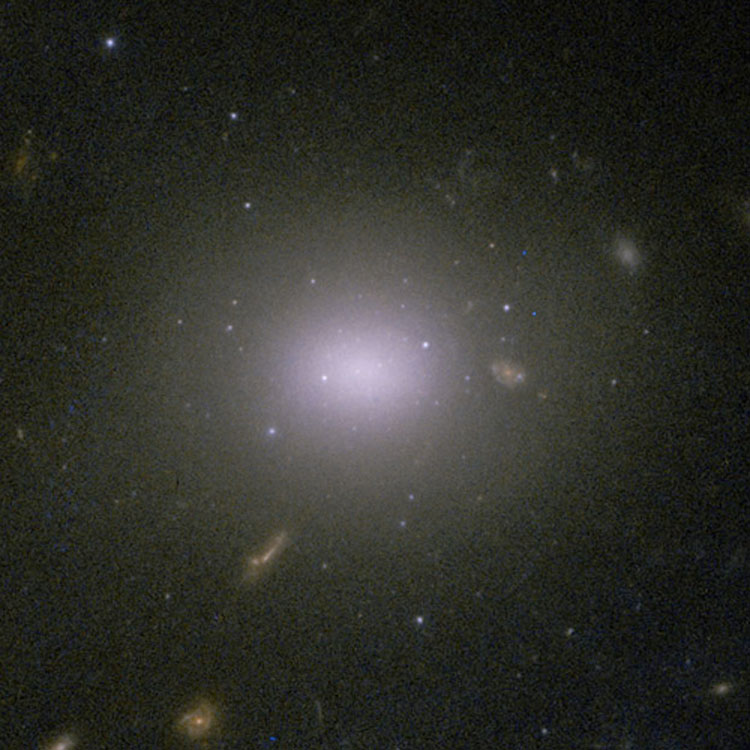
IC 695 (= PGC 170143)
Discovered (Apr 21, 1892) by Stephane Javelle (197)
A 15th-magnitude spiral galaxy (type Sc?) in Crater (RA 11 27 58.3, Dec -11 42 56)
Apparent size 0.7 by 0.2 arcmin.

Above, a 2.4 arcmin wide closeup of IC 695
Below, a 12 arcmin wide region centered on the galaxy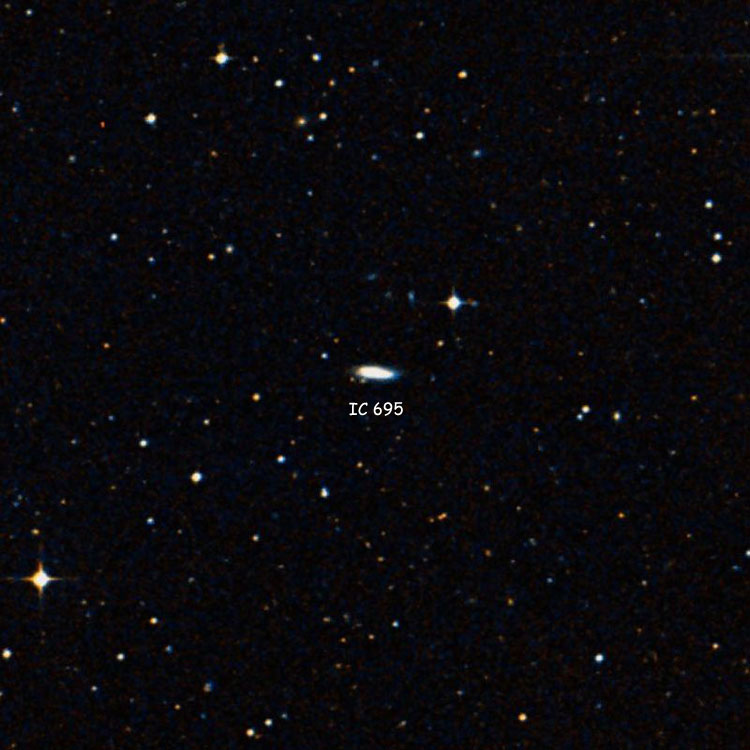
IC 696 (= PGC 35332)
Discovered (Mar 31, 1892) by Rudolf Spitaler (38)
A 14th-magnitude spiral galaxy (type SBdm?) in Leo (RA 11 28 39.9, Dec +09 05 55)
Apparent size 0.9 by 0.9 arcmin.
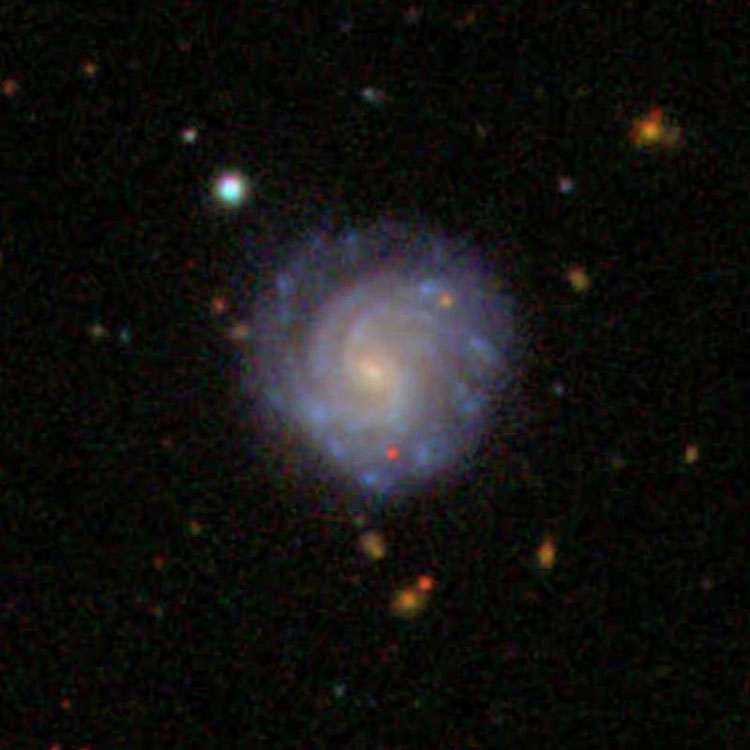
Above, a 2.4 arcmin wide closeup of IC 696
Below, a 12 arcmin wide region centered on the galaxy, also showing IC 698, 2857 and 2867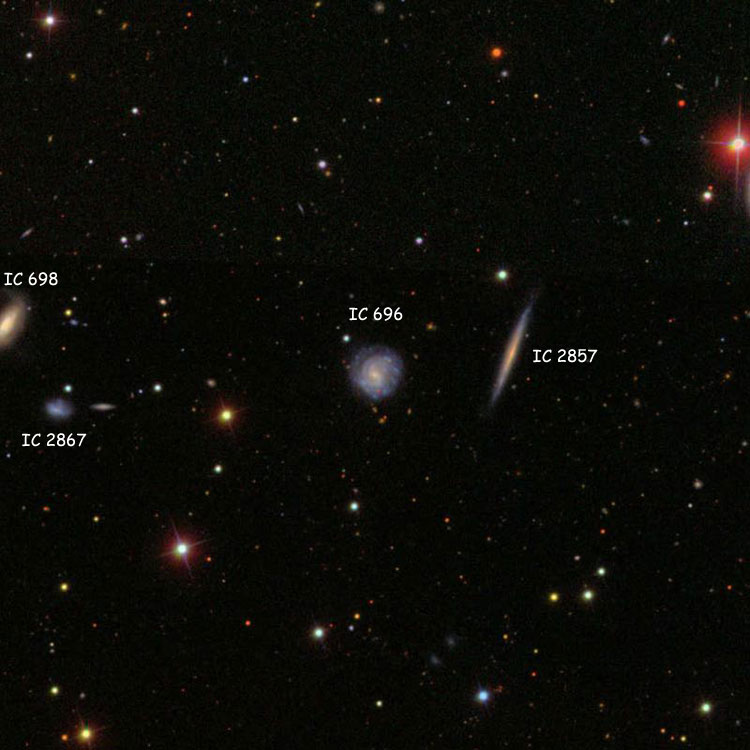
IC 697 (= PGC 35327)
Discovered (Apr 7, 1893) by Stephane Javelle (720)
A 14th-magnitude lenticular galaxy (type S0?) in Leo (RA 11 28 34.5, Dec -01 37 47)
Apparent size 0.7 by 0.4 arcmin.
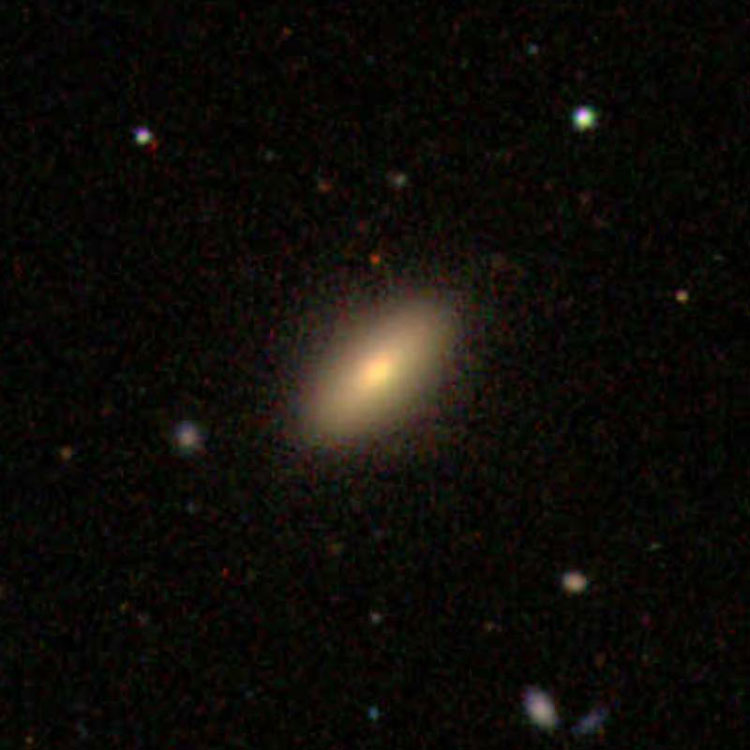
Above, a 2.4 arcmin wide closeup of IC 697
Below, a 12 arcmin wide region centered on the galaxy
IC 698 (= PGC 35364)
Discovered (Mar 31, 1892) by Rudolf Spitaler (39)
A 13th-magnitude spiral galaxy (type Sb? pec) in Leo (RA 11 29 03.8, Dec +09 06 44)
Apparent size 1.1 by 0.5 arcmin.

Above, a 2.4 arcmin wide closeup of IC 698
Below, a 12 arcmin wide region centered on the galaxy, also showing IC 696 and 2867
IC 699 (= PGC 35365)
Discovered (Mar 31, 1892) by Rudolf Spitaler (40)
A 14th-magnitude spiral galaxy (type (R)Sa(r)?) in Leo (RA 11 29 06.5, Dec +08 59 18)
Apparent size 1.2 by 0.35 arcmin.
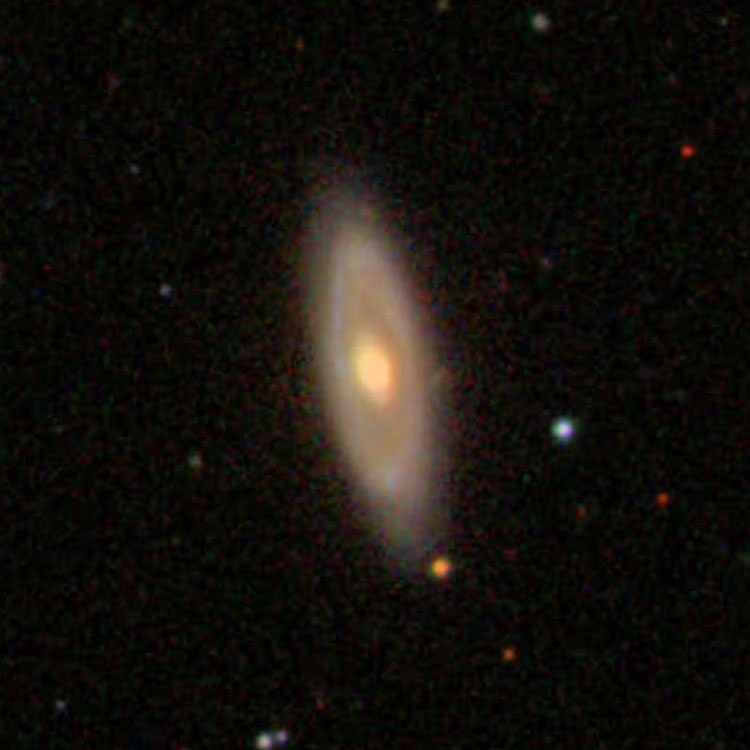
Above, a 2.4 arcmin wide closeup of IC 699
Below, a 12 arcmin wide region centered on the galaxy